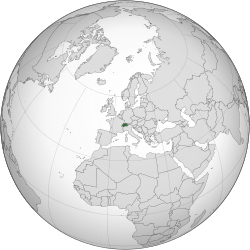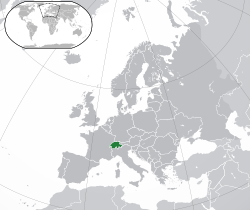Switzerland
Swiss Confederation | |
|---|---|
| Motto: (unofficial) "Unus pro omnibus, omnes pro uno" "One for all, all for one" | |
| Anthem: "Swiss Psalm" | |
Location of Switzerland (green) in Europe (green and dark grey) | |
| Capital | 46°57′N 7°27′E / 46.950°N 7.450°E |
| Largest city | Zurich |
| Official languages | |
| Religion (2022)[3] |
|
| Demonym(s) | |
| Government | Federal assembly-independent[4][5] directorial republic |
| Viktor Rossi | |
| Legislature | Federal Assembly |
| Council of States | |
| National Council | |
| History | |
• Founded | 1 August 1291[b] |
• Sovereignty recognised (Peace of Westphalia) | 24 October 1648 |
| 7 August 1815 | |
| 12 September 1848[c][6] | |
| Area | |
• Total | 41,285 km2 (15,940 sq mi) (132nd) |
• Water (%) | 4.34[7] |
| Population | |
• 2023 estimate | |
• 2015 census | |
• Density | 207/km2 (536.1/sq mi) (48th) |
| GDP (PPP) | 2024 estimate |
• Total | |
• Per capita | |
| GDP (nominal) | 2024 estimate |
• Total | |
• Per capita | |
| Gini (2023) | medium inequality |
| HDI (2022) | very high (1st) |
| Currency | Swiss franc (CHF) |
| Time zone | UTC+1 (CET) |
• Summer (DST) | UTC+2 (CEST) |
| Date format | dd.mm.yyyy (Anno Domini) |
| Drives on | right |
| Calling code | +41 |
| ISO 3166 code | CH |
| Internet TLD | .ch, .swiss |
Switzerland, officially the Swiss Confederation, is a landlocked country located in west-central Europe.[d][13] It is bordered by Italy to the south, France to the west, Germany to the north, and Austria and Liechtenstein to the east. Switzerland is geographically divided among the Swiss Plateau, the Alps and the Jura; the Alps occupy the greater part of the territory, whereas most of the country's population of 9 million are concentrated on the plateau, which hosts its largest cities and economic centres, including Zurich, Geneva, and Basel.[14]
Switzerland originates from the Old Swiss Confederacy established in the Late Middle Ages, following a series of military successes against Austria and Burgundy; the Federal Charter of 1291 is considered the country's founding document. Swiss independence from the Holy Roman Empire was formally recognised in the Peace of Westphalia in 1648. Switzerland has maintained a policy of armed neutrality since the 16th century and has not fought an international war since 1815. It joined the United Nations only in 2002 but pursues an active foreign policy that includes frequent involvement in peace building.[15]
Switzerland is the birthplace of the Red Cross and hosts the headquarters or offices of most major international institutions including the WTO, the WHO, the ILO, FIFA, the WEF, and the UN. It is a founding member of the European Free Trade Association (EFTA), but not part of the European Union (EU), the European Economic Area, or the eurozone; however, it participates in the European single market and the Schengen Area. Switzerland is a federal republic composed of 26 cantons, with federal authorities based in Bern.[a][2][1]
Switzerland is one of the world's most developed countries and ranks 1st on the Human Development Index. It has the highest nominal wealth per adult[16] and the eighth-highest gross domestic product (GDP) per capita.[17][18] Switzerland performs highly on several international metrics, including economic competitiveness and democratic governance. Cities such as Zurich, Geneva and Basel rank among the highest in terms of quality of life,[19][20] albeit with some of the highest costs of living.[21] Switzerland holds an international reputation for its established banking sector, alongside its distinctive recognition for their watchmaking and chocolate production.
It has four main linguistic and cultural regions: German, French, Italian and Romansh. Although most Swiss are German-speaking, national identity is fairly cohesive, being rooted in a common historical background, shared values such as federalism and direct democracy,[22] and Alpine symbolism.[23][24] Swiss identity transcends language, ethnicity, and religion, leading to Switzerland being described as a Willensnation ("nation of volition") rather than a nation state.[25]
Etymology
The English name Switzerland is a portmanteau of Switzer, an obsolete term for a Swiss person which was in use during the 16th to 19th centuries, and land.[26] The English adjective Swiss is a loanword from French Suisse, also in use since the 16th century. The name Switzer is from the Alemannic Schwiizer, in origin an inhabitant of Schwyz and its associated territory, one of the Waldstätte cantons which formed the nucleus of the Old Swiss Confederacy. The Swiss began to adopt the name for themselves after the Swabian War of 1499, used alongside the term for "Confederates", Eidgenossen (literally: comrades by oath), used since the 14th century. The data code for Switzerland, CH, is derived from Latin Confoederatio Helvetica (Helvetic Confederation).
The toponym Schwyz itself was first attested in 972, as Old High German Suittes, perhaps related to swedan 'to burn' (cf. Old Norse svíða 'to singe, burn'), referring to the area of forest that was burned and cleared to build.[27] The name was extended to the area dominated by the canton, and after the Swabian War of 1499 gradually came to be used for the entire Confederation.[28][29] The Swiss German name of the country, Schwiiz, is homophonous to that of the canton and the settlement, but distinguished by the use of the definite article (d'Schwiiz for the Confederation,[30] but simply Schwyz for the canton and the town).[31] The long [iː] of Swiss German is historically and still often today spelled ⟨y⟩ rather than ⟨ii⟩, preserving the original identity of the two names even in writing.
The Latin name Confoederatio Helvetica was neologised and introduced gradually after the formation of the federal state in 1848, harking back to the Napoleonic Helvetic Republic. It appeared on coins from 1879, inscribed on the Federal Palace in 1902 and after 1948 used in the official seal[32] (e.g., the ISO banking code "CHF" for the Swiss franc, the Swiss postage stamps ('HELVETIA') and the country top-level domain ".ch", are both taken from the state's Latin name). Helvetica is derived from the Helvetii, a Gaulish tribe living on the Swiss Plateau before the Roman era.
Helvetia appeared as a national personification of the Swiss confederacy in the 17th century in a 1672 play by Johann Caspar Weissenbach.[33]
History
The state of Switzerland took its present form with the adoption of the Swiss Federal Constitution in 1848. Switzerland's precursors established a defensive alliance in 1291, forming a loose confederation that persisted for centuries.
Beginnings
The oldest traces of hominid existence in Switzerland date to about 150,000 years ago.[34] The oldest known farming settlements in Switzerland, which were found at Gächlingen, date to around 5300 BC.[34]
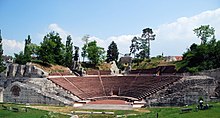
The earliest known tribes formed the Hallstatt and La Tène cultures, named after the archaeological site of La Tène on the north side of Lake Neuchâtel. La Tène culture developed and flourished during the late Iron Age from around 450 BC,[34] possibly influenced by Greek and Etruscan civilisations. One of the most prominent La Tène tribes were the Helvetii, who primarily occupied the Swiss Plateau, alongside the Rhaetians in the eastern regions. Facing pressures from Germanic tribes, in 58 BC, the Helvetii, influenced by Orgetorix, a wealthy aristocrat, decided to abandon the Swiss Plateau for better opportunities in western Gallia. After Orgetorix's mysterious death, the tribe continued their migration but was decisively defeated by Julius Caesar's armies at the Battle of Bibracte, in present-day eastern France. Following their defeat, the Helvetii were forced by Caesar to return to their original lands, where they were subjected to stringent restrictions on their autonomy and movements.[34] In 15 BC, Tiberius (later the second Roman emperor) and his brother Drusus conquered the Alps, integrating them into the Roman Empire. The area occupied by the Helvetii first became part of Rome's Gallia Belgica province and then of its Germania Superior province. The eastern portion of modern Switzerland was integrated into the Roman province of Raetia. Sometime around the start of the Common Era, the Romans maintained a large camp called Vindonissa, now a ruin at the confluence of the Aare and Reuss rivers, near the town of Windisch.[36]
The first and second century AD was an age of prosperity on the Swiss Plateau. Towns such as Aventicum, Iulia Equestris and Augusta Raurica reached a remarkable size, while hundreds of agricultural estates (Villae rusticae) were established in the countryside.[37]
Around 260 AD, the fall of the Agri Decumates territory north of the Rhine transformed today's Switzerland into a frontier land of the Empire. Repeated raids by the Alamanni tribes provoked the ruin of the Roman towns and economy, forcing the population to shelter near Roman fortresses, like the Castrum Rauracense near Augusta Raurica. The Empire built another line of defence at the north border (the so-called Donau-Iller-Rhine-Limes). At the end of the fourth century, the increased Germanic pressure forced the Romans to abandon the linear defence concept. The Swiss Plateau was finally open to Germanic tribes.[citation needed]
In the Early Middle Ages, from the end of the fourth century, the western extent of modern-day Switzerland was part of the territory of the Kings of the Burgundians, who introduced the French language to the area. The Alemanni settled the Swiss Plateau in the fifth century and the valleys of the Alps in the eighth century, forming Alemannia. Modern-day Switzerland was then divided between the kingdoms of Alemannia and Burgundy.[34] The entire region became part of the expanding Frankish Empire in the sixth century, following Clovis I's victory over the Alemanni at Tolbiac in 504 AD, and later Frankish domination of the Burgundians.[38][39]
Throughout the rest of the sixth, seventh and eighth centuries, Swiss regions continued under Frankish hegemony (Merovingian and Carolingian dynasties) but after its extension under Charlemagne, the Frankish Empire was divided by the Treaty of Verdun in 843.[34] The territories of present-day Switzerland became divided into Middle Francia and East Francia until they were reunified under the Holy Roman Empire around 1000 AD.[34]
In the 10th century, as the rule of the Carolingians waned, Magyars destroyed Basel in 917 and St. Gallen in 926. In response, Henry the Fowler, the then ruler of East Francia, decreed the fortification of key settlements to defend against these invasions. Large villages and towns, including strategic locations like Zurich and St.Gallen, were fortified. This initiative led to the development of what were essentially early urban strongholds and city governments in Eastern Switzerland.[37]
By 1200, the Swiss Plateau comprised the dominions of the houses of Savoy, Zähringer, Habsburg, and Kyburg.[34] Some regions (Uri, Schwyz, Unterwalden, later known as Waldstätten) were accorded the Imperial immediacy to grant the empire direct control over the mountain passes. With the extinction of its male line in 1263, the Kyburg dynasty fell in AD 1264. The Habsburgs under King Rudolph I (Holy Roman Emperor in 1273) laid claim to the Kyburg lands and annexed them, extending their territory to the eastern Swiss Plateau.[38]
Old Swiss Confederacy
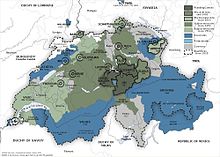

The Old Swiss Confederacy was an alliance among the valley communities of the central Alps. The Confederacy was governed by nobles and patricians of various cantons who facilitated management of common interests and ensured peace on mountain trade routes. The Federal Charter of 1291 is considered the confederacy's founding document, even though similar alliances likely existed decades earlier. The document was agreed among the rural communes of Uri, Schwyz, and Unterwalden.[40][page needed][41]
By 1353, the three original cantons had joined with the cantons of Glarus and Zug and the Lucerne, Zurich and Bern city-states to form the "Old Confederacy" of eight states that obtained through the end of the 15th century.[41] The expansion led to increased power and wealth for the confederation. By 1460, the confederates controlled most of the territory south and west of the Rhine to the Alps and the Jura mountains, and the University of Basel was founded (with a faculty of medicine) establishing a tradition of chemical and medical research. This increased after victories against the Habsburgs (Battle of Sempach, Battle of Näfels), over Charles the Bold of Burgundy during the 1470s, and the success of the Swiss mercenaries. The Swiss victory in the Swabian War against the Swabian League of Emperor Maximilian I in 1499 amounted to de facto independence within the Holy Roman Empire.[41] In 1501, Basel[42] and Schaffhausen joined the Old Swiss Confederacy.[43]
The Confederacy acquired a reputation of invincibility during these earlier wars, but expansion of the confederation suffered a setback in 1515 with the Swiss defeat in the Battle of Marignano. This ended the so-called "heroic" epoch of Swiss history.[41] The success of Zwingli's Reformation in some cantons led to inter-cantonal religious conflicts in 1529 and 1531 (Wars of Kappel). It was not until more than one hundred years after these internal wars that, in 1648, under the Peace of Westphalia, European countries recognised Switzerland's independence from the Holy Roman Empire and its neutrality.[38][39]
During the Early Modern period of Swiss history, the growing authoritarianism of the patriciate families[44] combined with a financial crisis in the wake of the Thirty Years' War led to the Swiss peasant war of 1653. In the background to this struggle, the conflict between Catholic and Protestant cantons persisted, erupting in further violence at the First War of Villmergen, in 1656, and the Toggenburg War (or Second War of Villmergen), in 1712.[41]
Napoleonic era
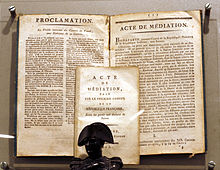
In 1798, the revolutionary French government invaded Switzerland and imposed a new unified constitution.[41] This centralised the government of the country, effectively abolishing the cantons: moreover, Mülhausen left Switzerland and the Valtellina valley became part of the Cisalpine Republic. The new regime, known as the Helvetic Republic, was highly unpopular. An invading foreign army had imposed and destroyed centuries of tradition, making Switzerland nothing more than a French satellite state. The fierce French suppression of the Nidwalden Revolt in September 1798 was an example of the oppressive presence of the French Army and the local population's resistance to the occupation.[citation needed]
When war broke out between France and its rivals, Russian and Austrian forces invaded Switzerland. The Swiss refused to fight alongside the French in the name of the Helvetic Republic. In 1803 Napoleon organised a meeting of the leading Swiss politicians from both sides in Paris. The Act of Mediation was the result, which largely restored Swiss autonomy and introduced a Confederation of 19 cantons.[41] Henceforth, much of Swiss politics would concern balancing the cantons' tradition of self-rule with the need for a central government.[45]
In 1815 the Congress of Vienna fully re-established Swiss independence, and the European powers recognised permanent Swiss neutrality.[38][39][41] Swiss troops served foreign governments until 1860 when they fought in the siege of Gaeta. The treaty allowed Switzerland to increase its territory, with the admission of the cantons of Valais, Neuchâtel and Geneva. Switzerland's borders saw only minor adjustments thereafter.[46]
Federal state
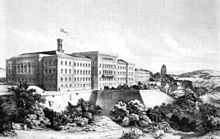
The restoration of power to the patriciate was only temporary. After a period of unrest with repeated violent clashes, such as the Züriputsch of 1839, civil war (the Sonderbundskrieg) broke out in 1847 when some Catholic cantons tried to set up a separate alliance (the Sonderbund).[41] The war lasted less than a month, causing fewer than 100 casualties, most of which were through friendly fire. The Sonderbundskrieg had a significant impact on the psychology and society of Switzerland.[citation needed][who?]
The war convinced most Swiss of the need for unity and strength. Swiss from all strata of society, whether Catholic or Protestant, from the liberal or conservative current, realised that the cantons would profit more from merging their economic and religious interests.[citation needed]
Thus, while the rest of Europe saw revolutionary uprisings, the Swiss drew up a constitution that provided for a federal layout, much of it inspired by the American example. This constitution provided central authority while leaving the cantons the right to self-government on local issues. Giving credit to those who favoured the power of the cantons (the Sonderbund Kantone), the national assembly was divided between an upper house (the Council of States, two representatives per canton) and a lower house (the National Council, with representatives elected from across the country). Referendums were made mandatory for any amendments.[39] This new constitution ended the legal power of nobility in Switzerland.[47]

A single system of weights and measures was introduced, and in 1850 the Swiss franc became the Swiss single currency, complemented by the WIR franc in 1934.[48] Article 11 of the constitution forbade sending troops to serve abroad, marking the end of foreign service. It came with the expectation of serving the Holy See, and the Swiss were still obliged to serve Francis II of the Two Sicilies with Swiss Guards present at the siege of Gaeta in 1860.[citation needed]
An important clause of the constitution was that it could be entirely rewritten, if necessary, thus enabling it to evolve as a whole rather than being modified one amendment at a time.[49][page needed]
This need soon proved itself when the rise in population and the Industrial Revolution that followed led to calls to modify the constitution accordingly. The population rejected an early draft in 1872, but modifications led to its acceptance in 1874.[41] It introduced the facultative referendum for laws at the federal level. It also established federal responsibility for defence, trade, and legal matters.
In 1891, the constitution was revised with uncommonly strong elements of direct democracy, which remain unique today.[41]
Modern history
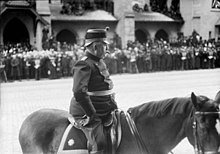
Switzerland was not invaded during either of the world wars. During World War I, Switzerland was home to the revolutionary and founder of the Soviet Union Vladimir Illych Ulyanov (Vladimir Lenin) who remained there until 1917.[50] Swiss neutrality was seriously questioned by the short-lived Grimm–Hoffmann affair in 1917. In 1920, Switzerland joined the League of Nations, which was based in Geneva, after it was exempted from military requirements.[51]
During World War II, detailed invasion plans were drawn up by the Germans,[52] but Switzerland was never attacked.[41] Switzerland was able to remain independent through a combination of military deterrence, concessions to Germany, and good fortune, as larger events during the war intervened.[39][53] General Henri Guisan, appointed the commander-in-chief for the duration of the war ordered a general mobilisation of the armed forces. The Swiss military strategy changed from static defence at the borders to organised long-term attrition and withdrawal to strong, well-stockpiled positions high in the Alps, known as the Reduit. Switzerland was an important base for espionage by both sides and often mediated communications between the Axis and Allied powers.[53]
Switzerland's trade was blockaded by both the Allies and the Axis. Economic cooperation and extension of credit to Nazi Germany varied according to the perceived likelihood of invasion and the availability of other trading partners. Concessions reached a peak after a crucial rail link through Vichy France was severed in 1942, leaving Switzerland (together with Liechtenstein) entirely isolated from the wider world by Axis-controlled territory. Over the course of the war, Switzerland interned over 300,000 refugees[54] aided by the International Red Cross, based in Geneva. Strict immigration and asylum policies and the financial relationships with Nazi Germany raised controversy, only at the end of the 20th century.[55]: 521
During the war, the Swiss Air Force engaged aircraft of both sides, shooting down 11 intruding Luftwaffe planes in May and June 1940, then forcing down other intruders after a change of policy following threats from Germany. Over 100 Allied bombers and their crews were interned. Between 1940 and 1945, Switzerland was bombed by the Allies, causing fatalities and property damage.[53] Among the cities and towns bombed were Basel, Brusio, Chiasso, Cornol, Geneva, Koblenz, Niederweningen, Rafz, Renens, Samedan, Schaffhausen, Stein am Rhein, Tägerwilen, Thayngen, Vals, and Zurich. Allied forces maintained that the bombings, which violated the 96th Article of War, resulted from navigation errors, equipment failure, weather conditions, and pilot errors. The Swiss expressed fear and concern that the bombings were intended to put pressure on Switzerland to end economic cooperation and neutrality with Nazi Germany.[56] Court-martial proceedings took place in England. The US paid SFR 62M for reparations.[citation needed]
Switzerland's attitude towards refugees was complicated and controversial; over the course of the war, it admitted as many as 300,000 refugees[54] while refusing tens of thousands more,[55]: 107 including Jews persecuted by the Nazis.[55]: 114
After the war, the Swiss government exported credits through the charitable fund known as the Schweizerspende and donated to the Marshall Plan to help Europe's recovery, efforts that ultimately benefited the Swiss economy.[55]: 521
During the Cold War, Swiss authorities considered the construction of a Swiss nuclear bomb.[57] Leading nuclear physicists at the Federal Institute of Technology Zurich such as Paul Scherrer made this a realistic possibility.[58] In 1988, the Paul Scherrer Institute was founded in his name to explore the therapeutic uses of neutron scattering technologies.[59] Financial problems with the defence budget and ethical considerations prevented the substantial funds from being allocated, and the Nuclear Non-Proliferation Treaty of 1968 was seen as a valid alternative. Plans for building nuclear weapons were dropped by 1988.[60] Switzerland joined the Council of Europe in 1963.[39]
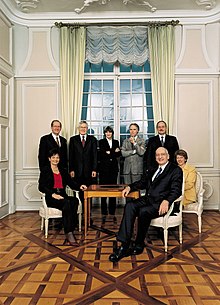
Switzerland was the last Western republic (the Principality of Liechtenstein followed in 1984) to grant women the right to vote. Some Swiss cantons approved this in 1959, while at the federal level, it was achieved in 1971[41][61][failed verification] and, after resistance, in the last canton Appenzell Innerrhoden (one of only two remaining Landsgemeinde, along with Glarus) in 1990. After obtaining suffrage at the federal level, women quickly rose in political significance. The first woman on the seven-member Federal Council executive was Elisabeth Kopp, who served from 1984 to 1989,[41] and the first female president was Ruth Dreifuss in 1999.[62]
In 1979 areas from the canton of Bern attained independence from the Bernese, forming the new canton of Jura. On 18 April 1999, the Swiss population and the cantons voted in favour of a completely revised federal constitution.[41]
In 2002 Switzerland became a full member of the United Nations, leaving Vatican City as the last widely recognised state without full UN membership. Switzerland is a founding member of the EFTA but not the European Economic Area (EEA). An application for membership in the European Union was sent in May 1992, but did not advance since rejecting the EEA in December 1992[41] when Switzerland conducted a referendum on the EEA. Several referendums on the EU issue ensued; due to opposition from the citizens, the membership application was withdrawn. Nonetheless, Swiss law is gradually changing to conform with that of the EU, and the government signed bilateral agreements with the European Union. Switzerland, together with Liechtenstein, has been surrounded by the EU since Austria's entry in 1995. On 5 June 2005, Swiss voters agreed by a 55% majority to join the Schengen treaty, a result that EU commentators regarded as a sign of support.[39] In September 2020, a referendum calling for a vote to end the pact that allowed a free movement of people from the European Union was introduced by the Swiss People's Party (SVP).[63] However, voters rejected the attempt to retake control of immigration, defeating the motion by a roughly 63%–37% margin.[64]
On 9 February 2014, 50.3% of Swiss voters approved a ballot initiative launched by the Swiss People's Party (SVP/UDC) to restrict immigration. This initiative was mostly backed by rural (57.6% approval) and suburban groups (51.2% approval), and isolated towns (51.3% approval) as well as by a strong majority (69.2% approval) in Ticino, while metropolitan centres (58.5% rejection) and the French-speaking part (58.5% rejection) rejected it.[65] In December 2016, a political compromise with the EU was attained that eliminated quotas on EU citizens, but still allowed favourable treatment of Swiss-based job applicants.[66] On 27 September 2020, 62% of Swiss voters rejected the anti-free movement referendum by SVP.[67]
Geography

Extending across the north and south side of the Alps in west-central Europe, Switzerland encompasses diverse landscapes and climates across its 41,285 square kilometres (15,940 sq mi).[68]
Switzerland lies between latitudes 45° and 48° N, and longitudes 5° and 11° E. It contains three basic topographical areas: the Swiss Alps to the south, the Swiss Plateau or Central Plateau, and the Jura mountains on the west. The Alps are a mountain range running across the central and south of the country, constituting about 60% of the country's area. The majority of the population live on the Swiss Plateau. The Swiss Alps host many glaciers, covering 1,063 square kilometres (410 sq mi). From these originate the headwaters of several major rivers, such as the Rhine, Inn, Ticino and Rhône, which flow in the four cardinal directions, spreading across Europe. The hydrographic network includes several of the largest bodies of fresh water in Central and Western Europe, among which are Lake Geneva (Lac Léman in French), Lake Constance (Bodensee in German) and Lake Maggiore. Switzerland has more than 1500 lakes and contains 6% of Europe's freshwater stock. Lakes and glaciers cover about 6% of the national territory. Lake Geneva is the largest lake and is shared with France. The Rhône is both the main source and outflow of Lake Geneva. Lake Constance is the second largest and, like Lake Geneva, an intermediate step by the Rhine at the border with Austria and Germany. While the Rhône flows into the Mediterranean Sea at the French Camargue region and the Rhine flows into the North Sea at Rotterdam, about 1,000 kilometres (620 miles) apart, both springs are only about 22 kilometres (14 miles) apart in the Swiss Alps.[68][69] 90% of Switzerland’s 65,000-kilometre-long network of rivers and streams have been straightened, dammed, canalized or channeled underground, in an effort to prevent natural disasters such as flooding, landslides, and avalanches.[70] 80% of all Swiss drinking water comes from groundwater sources.[71]
Forty-eight mountains are 4,000 metres (13,000 ft) or higher in height.[68] At 4,634 m (15,203 ft), Monte Rosa is the highest, although the Matterhorn (4,478 m or 14,692 ft) is the best known. Both are located within the Pennine Alps in the canton of Valais, on the border with Italy. The section of the Bernese Alps above the deep glacial Lauterbrunnen valley, containing 72 waterfalls, is well known for the Jungfrau (4,158 m or 13,642 ft) Eiger and Mönch peaks, and its many picturesque valleys. In the southeast the long Engadin Valley, encompassing St. Moritz, is also well known; the highest peak in the neighbouring Bernina Alps is Piz Bernina (4,049 m or 13,284 ft).[68]
The Swiss Plateau has greater open and hilly landscapes, partly forested, partly open pastures, usually with grazing herds or vegetable and fruit fields, but it is still hilly. Large lakes and the biggest Swiss cities are found there.[68]
Switzerland contains two small enclaves: Büsingen belongs to Germany, while Campione d'Italia belongs to Italy.[72] Switzerland has no exclaves.
Climate
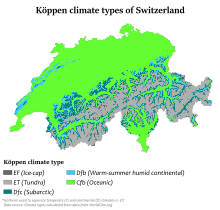
The Swiss climate is generally temperate, but can vary greatly across localities,[73] from glacial conditions on the mountaintops to the near-Mediterranean climate at Switzerland's southern tip. Some valley areas in the southern part of Switzerland offer cold-hardy palm trees. Summers tend to be warm and humid at times with periodic rainfall, ideal for pastures/grazing. The less humid winters in the mountains may see weeks-long intervals of stable conditions. At the same time, the lower lands tend to suffer from inversion during such periods, hiding the sun.[citation needed]
A weather phenomenon known as the föhn (with an identical effect to the chinook wind) can occur any time and is characterised by an unexpectedly warm wind, bringing low relative humidity air to the north of the Alps during rainfall periods on the south-facing slopes. This works both ways across the alps but is more efficient if blowing from the south due to the steeper step for oncoming wind. Valleys running south to north trigger the best effect. The driest conditions persist in all inner alpine valleys that receive less rain because arriving clouds lose a lot of their moisture content while crossing the mountains before reaching these areas. Large alpine areas such as Graubünden remain drier than pre-alpine areas, and as in the main valley of the Valais, wine grapes are grown there.[74]
The wettest conditions persist in the high Alps and in the Ticino canton, which has much sun yet heavy bursts of rain from time to time.[74] Precipitation tends to be spread moderately throughout the year, with a peak in summer. Autumn is the driest season, winter receives less precipitation than summer, yet the weather patterns in Switzerland are not in a stable climate system. They can vary from year to year with no strict and predictable periods.[citation needed]
Environment
Switzerland contains two terrestrial ecoregions: Western European broadleaf forests and Alps conifer and mixed forests.[75]
Switzerland's many small valleys separated by high mountains often host unique ecologies. The mountainous regions themselves offer a rich range of plants not found at other altitudes. The climatic, geological and topographical conditions of the alpine region make for a fragile ecosystem that is particularly sensitive to climate change.[73][76] According to the 2014 Environmental Performance Index, Switzerland ranks first among 132 nations in safeguarding the environment, due to its high scores on environmental public health, its heavy reliance on renewable sources of energy (hydropower and geothermal energy), and its level of greenhouse gas emissions.[77] In 2020 it was ranked third out of 180 countries.[78] The country pledged to cut GHG emissions by 50% by 2030 compared to the level of 1990 and plans to reach zero emissions by 2050.[79]
However, access to biocapacity in Switzerland is far lower than the world average. In 2016, Switzerland had 1.0 hectares[80] of biocapacity per person within its territory, 40 per cent less than world average of 1.6. In contrast, in 2016, Swiss consumption required 4.6 hectares of biocapacity – their ecological footprint, 4.6 times as much as Swiss territory can support. The remainder comes from other countries and the shared resources (such as the atmosphere impacted by greenhouse gas emissions).[80] Switzerland had a 2019 Forest Landscape Integrity Index mean score of 3.53/10, ranking it 150th globally out of 172 countries.[81]
Switzerland is ranked 9th in Environmental Performance Index for year 2024.[82] This Index combines various indicators around known issues around the world and measures how good they fit in among each countries on a scale. Switzerland scores good in parameters like Air pollution, Sanitation and Drinking Water, Waste Management, Climate Change Mitigation etc.[83]
Urbanisation
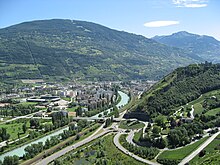
About 85% of the population live in urban areas.[84][85] Switzerland went from a largely rural country to an urban one from 1930 to 2000. After 1935 urban development claimed as much of the Swiss landscape as it did during the prior 2,000 years. Urban sprawl affects the plateau, the Jura and the Alpine foothills,[86] raising concerns about land use.[87] During the 21st century, population growth in urban areas is higher than in the countryside.[85]
Switzerland has a dense network of complementary large, medium and small towns.[85] The plateau is densely populated with about 400 people per km2 and the landscape shows uninterrupted signs of human presence.[88] The weight of the largest metropolitan areas – Zurich, Geneva–Lausanne, Basel and Bern – tend to increase.[85][clarification needed] The importance of these urban areas is greater than their population suggests.[85] These urban centers are recognised for their high quality of life.[89]
The average population density in 2019 was 215.2 inhabitants per square kilometre (557/sq mi).[90]: 79 In the largest canton by area, Graubünden, lying entirely in the Alps, population density falls to 28.0 inhabitants per square kilometre (73/sq mi).[90]: 30 In the canton of Zurich, with its large urban capital, the density is 926.8 per square kilometre (2,400/sq mi).[90]: 76
Government and politics

The Federal Constitution adopted in 1848 is the legal foundation of Switzerland's federal state.[91] A new Swiss Constitution was adopted in 1999 that did not introduce notable changes to the federal structure. It outlines rights of individuals and citizen participation in public affairs, divides the powers between the Confederation and the cantons and defines federal jurisdiction and authority. Three main bodies govern on the federal level:[92] the bicameral parliament (legislative), the Federal Council (executive) and the Federal Court (judicial).
Parliament
The Swiss Parliament consists of two houses: the Council of States which has 46 representatives (two from each canton and one from each half-canton) who are elected under a system determined by each canton, and the National Council, which consists of 200 members who are elected under a system of proportional representation, reflecting each canton's population. Members serve part-time for four years (a Milizsystem or citizen legislature).[93] When both houses are in joint session, they are known collectively as the Federal Assembly. Through referendums, citizens may challenge any law passed by parliament and, through initiatives, introduce amendments to the federal constitution, thus making Switzerland a direct democracy.[91]
Federal Council
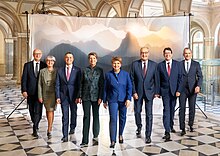
The Federal Council directs the federal government, the federal administration, and serves as a collective head of state. It is a collegial body of seven members, elected for a four-year term by the Federal Assembly, which also oversees the council. The President of the Confederation is elected by the Assembly from among the seven members, traditionally in rotation and for a one-year term; the President chairs the government and executes representative functions. The president is a primus inter pares with no additional powers and remains the head of a department within the administration.[91]
The government has been a coalition of the four major political parties since 1959, each party having a number of seats that roughly reflects its share of the electorate and representation in the federal parliament. The classic distribution of two CVP/PDC, two SPS/PSS, two FDP/PRD and one SVP/UDC as it stood from 1959 to 2003 was known as the "magic formula". Following the 2015 Federal Council elections, the seven seats in the Federal Council were distributed as follows:
- 1 seat for the Center Party (Die Mitte),[e]
- 2 seats for the Free Democratic Party (FDP/PRD),
- 2 seats for the Social Democratic Party (SPS/PSS),
- 2 seats for the Swiss People's Party (SVP/UDC).

Supreme Court
The function of the Federal Supreme Court is to hear appeals against rulings of cantonal or federal courts. The judges are elected by the Federal Assembly for six-year terms.[94]
Direct democracy

Direct democracy and federalism are hallmarks of the Swiss political system.[95] Swiss citizens are subject to three legal jurisdictions: the municipality, canton and federal levels. The 1848 and 1999 Swiss Constitutions define a system of direct democracy (sometimes called half-direct or representative direct democracy because it includes institutions of a representative democracy). The instruments of this system at the federal level, known as popular rights (German: Volksrechte, French: droits populaires, Italian: diritti popolari),[96] include the right to submit a federal initiative and a referendum, both of which may overturn parliamentary decisions.[91][97]
By calling a federal referendum, a group of citizens may challenge a law passed by parliament by gathering 50,000 signatures against the law within 100 days. If so, a national vote is scheduled where voters decide by a simple majority whether to accept or reject the law. Any eight cantons can also call a constitutional referendum on federal law.[91]
Similarly, the federal constitutional initiative allows citizens to put a constitutional amendment to a national vote, if 100,000 voters sign the proposed amendment within 18 months.[f] The Federal Council and the Federal Assembly can supplement the proposed amendment with a counterproposal. Then, voters must indicate a preference on the ballot if both proposals are accepted. Constitutional amendments, whether introduced by initiative or in parliament, must be accepted by a double majority of the national popular vote and the popular cantonal votes.[g][95]
Cantons
The Swiss Confederation consists of 26 cantons:[91][98]

|
| Canton | ID | Capital | Canton | ID | Capital | |||
|---|---|---|---|---|---|---|---|---|
| Aargau | 19 | Aarau | *Nidwalden | 7 | Stans | |||
| *Appenzell Ausserrhoden | 15 | Herisau | *Obwalden | 6 | Sarnen | |||
| *Appenzell Innerrhoden | 16 | Appenzell | Schaffhausen | 14 | Schaffhausen | |||
| *Basel-Landschaft | 13 | Liestal | Schwyz | 5 | Schwyz | |||
| *Basel-Stadt | 12 | Basel | Solothurn | 11 | Solothurn | |||
| Bern | 2 | Bern | St. Gallen | 17 | St. Gallen | |||
| Fribourg | 10 | Fribourg | Thurgau | 20 | Frauenfeld | |||
| Geneva | 25 | Geneva | Ticino | 21 | Bellinzona | |||
| Glarus | 8 | Glarus | Uri | 4 | Altdorf | |||
| Grisons | 18 | Chur | Valais | 23 | Sion | |||
| Jura | 26 | Delémont | Vaud | 22 | Lausanne | |||
| Lucerne | 3 | Lucerne | Zug | 9 | Zug | |||
| Neuchâtel | 24 | Neuchâtel | Zurich | 1 | Zurich | |||
*These cantons are known as half-cantons.
The cantons are federated states. They have a permanent constitutional status and, in comparison with other countries, a high degree of independence. Under the Federal Constitution, all 26 cantons are equal in status, except that 6 (referred to often as the half-cantons) are represented by one councillor instead of two in the Council of States and have only half a cantonal vote with respect to the required cantonal majority in referendums on constitutional amendments. Each canton has its own constitution and its own parliament, government, police and courts.[98] However, considerable differences define the individual cantons, particularly in terms of population and geographical area. Their populations vary between 16,003 (Appenzell Innerrhoden) and 1,487,969 (Zurich), and their area between 37 km2 (14 sq mi) (Basel-Stadt) and 7,105 km2 (2,743 sq mi) (Grisons).
Municipalities
As of 2018 the cantons comprised 2,222 municipalities.
Federal City
Until 1848, the loosely coupled Confederation did not have a central political organisation. Issues thought to affect the whole Confederation were the subject of periodic meetings in various locations.[99]
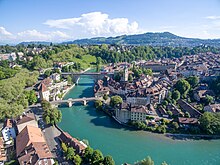
In 1848, the federal constitution provided that details concerning federal institutions, such as their locations, should be addressed by the Federal Assembly (BV 1848 Art. 108). Thus on 28 November 1848, the Federal Assembly voted in the majority to locate the seat of government in Bern and, as a prototypical federal compromise, to assign other federal institutions, such as the Federal Polytechnical School (1854, the later ETH) to Zurich, and other institutions to Lucerne, such as the later SUVA (1912) and the Federal Insurance Court (1917).[1] Other federal institutions were subsequently attributed to Lausanne (Federal Supreme Court in 1872, and EPFL in 1969), Bellinzona (Federal Criminal Court, 2004), and St. Gallen (Federal Administrative Court and Federal Patent Court, 2012).
The 1999 Constitution does not mention a Federal City and the Federal Council has yet to address the matter.[100] Thus no city in Switzerland has the official status either of capital or of Federal City. Nevertheless, Bern is commonly referred to as "Federal City" (German: Bundesstadt, French: ville fédérale, Italian: città federale).
Foreign relations and international institutions
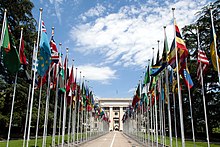
Traditionally, Switzerland avoids alliances that might entail military, political, or direct economic action and has been neutral since the end of its expansion in 1515. Its policy of neutrality was internationally recognised at the Congress of Vienna in 1815.[101][102] Swiss neutrality has been questioned at times.[103][104] In 2002 Switzerland became a full member of the United Nations.[101] It was the first state to join it by referendum. Switzerland maintains diplomatic relations with almost all countries and historically has served as an intermediary between other states.[101] Switzerland is not a member of the European Union; the Swiss people have consistently rejected membership since the early 1990s.[101] However, Switzerland does participate in the Schengen Area.[105]
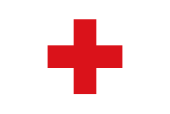
Many international institutions have headquarters in Switzerland, in part because of its policy of neutrality. Geneva is the birthplace of the Red Cross and Red Crescent Movement, the Geneva Conventions and, since 2006, hosts the United Nations Human Rights Council. Even though Switzerland is one of the most recent countries to join the United Nations, the Palace of Nations in Geneva is the second biggest centre for the United Nations after the headquarters in New York. Switzerland was a founding member and hosted the League of Nations.[51]
Apart from the United Nations headquarters, the Swiss Confederation is host to many UN agencies, including the World Health Organization (WHO), the International Labour Organization (ILO), the International Telecommunication Union (ITU), the United Nations High Commissioner for Refugees (UNHCR) and about 200 other international organisations, including the World Trade Organization and the World Intellectual Property Organization.[101] The annual meetings of the World Economic Forum in Davos bring together business and political leaders from Switzerland and foreign countries to discuss important issues. The headquarters of the Bank for International Settlements (BIS) moved to Basel in 1930.[citation needed]
Many sports federations and organisations are located in the country, including the International Handball Federation in Basel, the International Basketball Federation in Geneva, the Union of European Football Associations (UEFA) in Nyon, the International Federation of Association Football (FIFA) and the International Ice Hockey Federation both in Zurich, the International Cycling Union in Aigle, and the International Olympic Committee in Lausanne.[107]
Switzerland became a member of the United Nations Security Council for the 2023–2024 period.[108] According to the 2024 Global Peace Index, Switzerland is the 6th most peaceful country in the world.[109]
Switzerland and the European Union
Although not a member, Switzerland maintains relationships with the EU and European countries through bilateral agreements. The Swiss have brought their economic practices largely into conformity with those of the EU, in an effort to compete internationally. EU membership faces considerable negative popular sentiment. It is opposed by the conservative SVP party, the largest party in the National Council, and not advocated by several other political parties. The membership application was formally withdrawn in 2016. The western French-speaking areas and the urban regions of the rest of the country tend to be more pro-EU, but do not form a significant share of the population.[110][111]
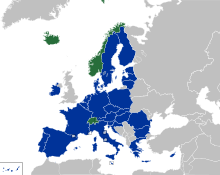
An Integration Office operates under the Department of Foreign Affairs and the Department of Economic Affairs. Seven bilateral agreements liberalised trade ties, taking effect in 2001. This first series of bilateral agreements included the free movement of persons. A second series of agreements covering nine areas was signed in 2004, including the Schengen Treaty and the Dublin Convention.[112]
In 2006, a referendum approved 1 billion francs of supportive investment in Southern and Central European countries in support of positive ties to the EU as a whole. A further referendum will be needed to approve 300 million francs to support Romania and Bulgaria and their recent admission.
The Swiss have faced EU and international pressure to reduce banking secrecy and raise tax rates to parity with the EU. Preparatory discussions involved four areas: the electricity market, participation in project Galileo, cooperating with the European Centre for Disease Prevention and Control and certificates of origin for food products.[113][needs update]
Switzerland is a member of the Schengen passport-free zone. Land border checkpoints monitor goods movements, but not people.[114]
Military
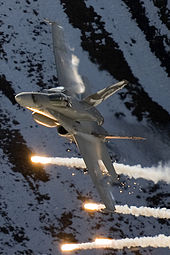
The Swiss Armed Forces, including the Land Forces and the Air Force, are composed mostly of conscripts, male citizens aged from 20 to 34 (in exceptional cases up to 50) years. Being a landlocked country, Switzerland has no navy; however, on lakes bordering neighbouring countries, armed boats patrol. Swiss citizens are prohibited from serving in foreign armies, except for the Swiss Guards of the Vatican, or if they are dual citizens of a foreign country and reside there.[citation needed]
The Swiss militia system stipulates that soldiers keep their army-issued equipment, including fully automatic personal weapons, at home.[115] Women can serve voluntarily. Men usually receive military conscription orders for training at the age of 18.[116] About two-thirds of young Swiss are found suitable for service; for the others, various forms of alternative service are available.[117] Annually, approximately 20,000 persons are trained in recruit centres for 18 to 21 weeks. The reform "Army XXI" was adopted by popular vote in 2003, replacing "Army 95", reducing the rolls from 400,000 to about 200,000. Of those, 120,000 are active in periodic Army training, and 80,000 are non-training reserves.[118]
The newest reform of the military, Weiterentwicklung der Armee (WEA; English: Further development of the Army), started in 2018 and was expected to reduce the number of army personnel to 100,000 by the end of 2022.[119][120]
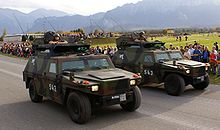
Overall, three general mobilisations have been declared to ensure the integrity and neutrality of Switzerland. The first mobilisation was held in response to the Franco-Prussian War of 1870–71; while the second was in response to the First World War outbreak in August 1914; the third mobilisation took place in September 1939 in response to the German attack on Poland.[121]
Because of its neutrality policy, the Swiss army does not take part in armed conflicts in other countries but joins some peacekeeping missions. Since 2000 the armed force department has maintained the Onyx intelligence gathering system to monitor satellite communications.[122]
Gun politics in Switzerland are unique in Europe in that 2–3.5 million guns are in the hands of civilians, giving the nation an estimate of 28–41 guns per 100 people.[123] As per the Small Arms Survey, only 324,484 guns are owned by the military.[124] Only 143,372 are in the hands of soldiers.[125] However, ammunition is no longer issued.[126][127]
Economy and labour law
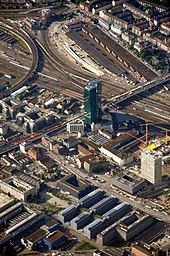
Switzerland has a stable, prosperous and high-tech economy. It is the world's wealthiest country per capita in multiple rankings.[citation needed] The country ranks as one of the least corrupt countries in the world,[129][130][131] while its banking sector is rated as "one of the most corrupt in the world".[132] It has the world's twentieth largest economy by nominal GDP and the thirty-eighth largest by purchasing power parity. As of 2021, it is the thirteenth largest exporter, and the fifth largest per capita. Zurich and Geneva are regarded as global cities, ranked as Alpha and Beta respectively. Basel is the capital of Switzerland's pharmaceutical industry, hosting Novartis, Roche, and many other players. It is one of the world's most important centres for the life sciences industry.[133]
Switzerland had the second-highest global rating in the Index of Economic Freedom 2023,[134] while also providing significant public services.[135] On a per capita basis, nominal GDP is higher than those of the larger Western and Central European economies and Japan,[136] while adjusted for purchasing power, Switzerland ranked 11th in 2017, fifth in 2018, and ninth in 2020.[137]
The 2016 World Economic Forum's Global Competitiveness Report ranked Switzerland's economy as the world's most competitive;[139] as of 2019, it ranks fifth globally.[140] The European Union labeled it Europe's most innovative country.[141] Switzerland has been ranked the most innovative country in the Global Innovation Index in 2024, as it had done in 2023, 2022, 2021, 2020 and 2019.[142][143][144][145] It ranked 20th of 189 countries in the Ease of Doing Business Index. Switzerland's slow growth in the 1990s and the early 2000s increased support for economic reforms and harmonisation with the European Union.[146][147] In 2020, IMD placed Switzerland first in attracting skilled workers.[148]
For much of the 20th century, Switzerland was the wealthiest country in Europe by a considerable margin (per capita GDP).[149] Switzerland has one of the world's largest account balances as a percentage of GDP.[150] In 2018, the canton of Basel-City had the highest GDP per capita, ahead of Zug and Geneva.[151] According to Credit Suisse, only about 37% of residents own their own homes, one of the lowest rates of home ownership in Europe. Housing and food price levels were 171% and 145% of the EU-25 index in 2007, compared to 113% and 104% in Germany.[152]
Switzerland is home to several large multinational corporations. The largest by revenue are Glencore, Gunvor, Nestlé, Mediterranean Shipping Company, Novartis, Hoffmann-La Roche, ABB, Mercuria Energy Group and Adecco.[153] Also, notable are UBS, Zurich Insurance, Richemont, Credit Suisse, Barry Callebaut, Swiss Re, Rolex, Tetra Pak, Swatch Group and Swiss International Air Lines.
Switzerland's most important economic sector is manufacturing. Manufactured products include specialty chemicals, health and pharmaceutical goods, scientific and precision measuring instruments and musical instruments. The largest exported goods are chemicals (34% of exported goods), machines/electronics (20.9%), and precision instruments/watches (16.9%).[152] The service sector – especially banking and insurance, commodities trading, tourism, and international organisations – is another important industry for Switzerland. Exported services amount to a third of exports.[152]
Agricultural protectionism—a rare exception to Switzerland's free trade policies—contributes to high food prices. Product market liberalisation is lagging behind many EU countries according to the OECD.[146] Apart from agriculture, economic and trade barriers between the European Union and Switzerland are minimal, and Switzerland has free trade agreements with many countries. Switzerland is a member of the European Free Trade Association (EFTA).
Switzerland is considered as the "land of Cooperatives" with the ten largest cooperative companies accounting for more than 11% of GDP in 2018. They include Migros and Coop, the two largest retail companies in Switzerland.[154]
Taxation and government spending
Switzerland is a tax haven.[155] The private sector economy dominates. It features low tax rates; tax revenue to GDP ratio is one of the smallest of developed countries. The Swiss Federal budget reached 62.8 billion Swiss francs in 2010, 11.35% of GDP; however, canton and municipality budgets are not counted as part of the federal budget. Total government spending is closer to 33.8% of GDP. The main sources of income for the federal government are the value-added tax (33% of tax revenue) and the direct federal tax (29%). The main areas of expenditure are in social welfare and finance/taxes. The expenditures of the Swiss Confederation have been growing from 7% of GDP in 1960 to 9.7% in 1990 and 10.7% in 2010. While the social welfare and finance sectors and tax grew from 35% in 1990 to 48.2% in 2010, a significant reduction of expenditures has been occurring in agriculture and national defence; from 26.5% to 12.4% (estimation for the year 2015).[156][157]
Labour force
Slightly more than 5 million people work in Switzerland;[158] about 25% of employees belonged to a trade union in 2004.[159] Switzerland has a more flexible labor market than neighbouring countries and the unemployment rate is consistently low.[160] The unemployment rate increased from 1.7% in June 2000 to 4.4% in December 2009.[161] It then decreased to 3.2% in 2014 and held steady for several years, before further dropping to 2.5% in 2018 and 2.3% in 2019; as of 2023[update] it had reached a 20-year low of 2%.[162] Population growth (from net immigration) reached 0.52% of population in 2004, increased in the following years before falling to 0.54% again in 2017.[152][163] The foreign citizen population was 28.9% in 2015, about the same as in Australia.[164]
In 2016, the median monthly gross income in Switzerland was 6,502 francs per month (equivalent to US$6,597 per month).[150] After rent, taxes and pension contributions, plus spending on goods and services, the average household has about 15% of its gross income left for savings. Though 61% of the population made less than the mean income, income inequality is relatively low with a Gini coefficient of 29.7, placing Switzerland among the top 20 countries. In 2015, the richest 1% owned 35% of the wealth.[165] Wealth inequality increased through 2019.[166]
About 8.2% of the population live below the national poverty line, defined in Switzerland as earning less than CHF3,990 per month for a household of two adults and two children, and a further 15% are at risk of poverty. Single-parent families, those with no post-compulsory education and those out of work are among the most likely to live below the poverty line. Although work is considered a way out of poverty, some 4.3% are considered working poor. One in ten jobs in Switzerland is considered low-paid; roughly 12% of Swiss workers hold such jobs, many of them women and foreigners.[150]
Education and science
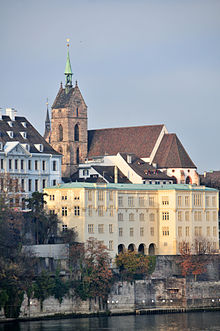
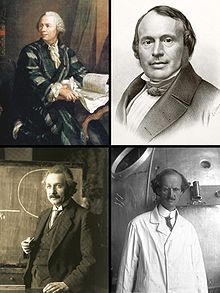
Leonhard Euler (mathematics)
Louis Agassiz (glaciology)
Auguste Piccard (aeronautics)
Albert Einstein (physics)
Education in Switzerland is diverse, because the constitution of Switzerland delegates the operation for the school system to the cantons.[167] Public and private schools are available, including many private international schools.
Primary education
The minimum age for primary school is about six years, but most cantons provide a free "children's school" starting at age four or five.[167] Primary school continues until grade four, five or six, depending on the school. Traditionally, the first foreign language in school was one of the other Swiss languages, although in 2000, English was elevated in a few cantons.[167] At the end of primary school or at the beginning of secondary school, pupils are assigned according to their capacities into one of several sections (often three). The fastest learners are taught advanced classes to prepare for further studies and the matura,[167] while other students receive an education adapted to their needs.
Tertiary education
Switzerland hosts 12 universities, ten of which are maintained at cantonal level and usually offer non-technical subjects. It ranked 87th on the 2019 Academic Ranking of World Universities.[168] The largest is the University of Zurich with nearly 25,000 students.[169] The Swiss Federal Institute of Technology Zurich (ETHZ) and the University of Zurich are listed 20th and 54th respectively, on the 2015 Academic Ranking of World Universities.[170]
The federal government sponsors two institutes: the Swiss Federal Institute of Technology Zurich (ETHZ) in Zurich, founded in 1855 and the École Polytechnique Fédérale de Lausanne (EPFL) in Lausanne, founded in 1969, formerly associated with the University of Lausanne.[i][171][172]
Eight of the world's ten best hotel schools are located in Switzerland.[173] In addition, various universities of applied sciences are available. In business and management studies, the University of St. Gallen, (HSG) is ranked 329th in the world according to QS World University Rankings[174] and the International Institute for Management Development (IMD), was ranked first in open programmes worldwide.[175] Switzerland has the second highest rate (almost 18% in 2003) of foreign students in tertiary education, after Australia (slightly over 18%).[176][177]
The Graduate Institute of International and Development Studies, located in Geneva, is continental Europe's oldest graduate school of international and development studies. It is widely held to be one of its most prestigious.[178][179]
Science
Switzerland has birthed many Nobel Prize laureates. They include Albert Einstein,[180] who developed his special relativity in Bern. Later, Vladimir Prelog, Heinrich Rohrer, Richard Ernst, Edmond Fischer, Rolf Zinkernagel, Kurt Wüthrich and Jacques Dubochet received Nobel science prizes. Over 100 laureates across all fields have a relationship to Switzerland.[181][j] The Nobel Peace Prize has been awarded nine times to organisations headquartered in Switzerland.[182]
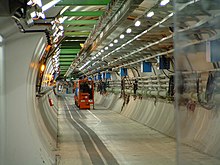
Geneva and the nearby French department of Ain co-host the world's largest laboratory, CERN,[184] dedicated to particle physics research. Another important research centre is the Paul Scherrer Institute.
Notable inventions include lysergic acid diethylamide (LSD), diazepam (Valium), the scanning tunnelling microscope (Nobel prize) and Velcro. Some technologies enabled the exploration of new worlds such as the pressurised balloon of Auguste Piccard and the Bathyscaphe which permitted Jacques Piccard to reach the deepest point of the world's oceans.
The Swiss Space Office has been involved in various space technologies and programmes. It was one of the 10 founders of the European Space Agency in 1975 and is the seventh largest contributor to the ESA budget. In the private sector, several companies participate in the space industry, such as Oerlikon Space[185] or Maxon Motors.[186]
Energy

Electricity generated in Switzerland is 56% from hydroelectricity and 39% from nuclear power, producing negligible CO2. On 18 May 2003, two anti-nuclear referendums were defeated: Moratorium Plus, aimed at forbidding the building of new nuclear power plants (41.6% supported),[187] and Electricity Without Nuclear (33.7% supported) after a moratorium expired in 2000.[188] After the Fukushima nuclear disaster, in 2011 the government announced plans to end the use of nuclear energy in the following 20 to 30 years.[189] In November 2016, Swiss voters rejected a Green Party referendum to accelerate the phaseout of nuclear power (45.8% supported).[190] The Swiss Federal Office of Energy (SFOE) is responsible for energy supply and energy use within the Federal Department of Environment, Transport, Energy and Communications (DETEC). The agency supports the 2000-watt society initiative to cut the nation's energy use by more than half by 2050.[191]
Transport

The densest rail network in Europe[61][failed verification] spans 5,250 kilometres (3,260 mi) and carries over 596 million passengers annually as of 2015.[192] In 2015, each Swiss resident travelled on average 2,550 kilometres (1,580 mi) by rail, more than any other European country.[192] Virtually 100% of the network is electrified. 60% of the network is operated by the Swiss Federal Railways (SBB CFF FFS). Besides the second largest standard gauge railway company, BLS AG, two railways companies operate on narrow gauge networks: the Rhaetian Railway (RhB) in Graubünden, which includes some World Heritage lines,[193] and the Matterhorn Gotthard Bahn (MGB), which co-operates with RhB the Glacier Express between Zermatt and St. Moritz/Davos. Switzerland operates the world's longest and deepest railway tunnel and the first flat, low-level route through the Alps, the 57.1-kilometre-long (35.5 mi) Gotthard Base Tunnel, the largest part of the New Railway Link through the Alps (NRLA) project.
Switzerland has a publicly managed, toll-free road network financed by highway permits as well as vehicle and petrol taxes. The Swiss autobahn/autoroute system requires the annual purchase of a vignette (toll sticker)—for 40 Swiss francs—to use its roadways, including passenger cars and trucks. The Swiss autobahn/autoroute network stretches for 1,638 km (1,018 mi) and has one of the highest motorway densities in the world.[194]
Zurich Airport is Switzerland's largest international flight gateway; it handled 22.8 million passengers in 2012.[195] The other international airports are Geneva Airport (13.9 million passengers in 2012),[196] EuroAirport Basel Mulhouse Freiburg (located in France), Bern Airport, Lugano Airport, St. Gallen-Altenrhein Airport and Sion Airport. Swiss International Air Lines is the flag carrier. Its main hub is Zurich, but it is legally domiciled in Basel.
Environment
Switzerland has one of the best environmental records among developed nations.[197] It is a signatory to the Kyoto Protocol. With Mexico and South Korea, it forms the Environmental Integrity Group (EIG).[198]
The country is active in recycling and anti-littering programs and is one of the world's top recyclers, recovering 66% to 96% of recyclable materials, varying across the country.[199] The 2014 Global Green Economy Index placed Switzerland among the top 10 green economies.[200]
Switzerland has an economic system for garbage disposal, which is based mostly on recycling and energy-producing incinerators.[201] As in other European countries, the illegal disposal of garbage is heavily fined. In almost all Swiss municipalities, mandatory stickers or dedicated garbage bags allow the identification of disposable garbage.[202]
Demographics
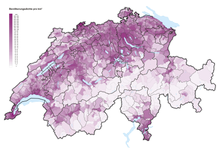
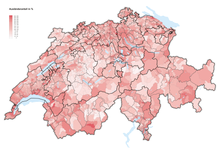
In common with other developed countries, the Swiss population increased rapidly during the industrial era, quadrupling between 1800 and 1990 and has continued to grow.
The population is about 9 million (2023 est.).[204] Population growth was projected into 2035, due mostly to immigration. Like most of Europe, Switzerland faces an ageing population, with a fertility rate close to replacement level.[205] Switzerland has one of the world's oldest populations, with an average age of 44.5 years.[206]
According to the World Factbook, ethnic groups in Switzerland are as follows: Swiss 69.2%, German 4.2%, Italian 3.2%, Portuguese 2.5%, French 2.1%, Kosovan 1.1%, Turkish 1%, other 16.7% (2020 est).[206] The Council of Europe figures suggest a population of around 30,000 Romani people in the country.[207]
Immigration
As of 2023, resident foreigners made up 26.3% of Switzerland's population.[14] Most of these (83%) were from European countries. Italy provided the largest single group of foreigners, providing 14.7% of total foreign population, followed closely by Germany (14.0%), Portugal (11.7%), France (6.6%), Kosovo (5.1%), Spain (3.9%), Turkey (3.1%), North Macedonia (3.1%), Serbia (2.8%), Austria (2.0%), United Kingdom (1.9%), Bosnia and Herzegovina (1.3%) and Croatia (1.3%). Immigrants from Sri Lanka (1.3%), most of them former Tamil refugees, were the largest group of Asian origin (7.9%).[208]
2021 figures show that 39.5% (compared to 34.7% in 2012) of the permanent resident population aged 15 or over (around 2.89 million), had an immigrant background. 38% of the population with an immigrant background (1.1 million) held Swiss citizenship.[209][210]
In the 2000s, domestic and international institutions expressed concern about what was perceived as an increase in xenophobia. In reply to one critical report, the Federal Council noted that "racism unfortunately is present in Switzerland", but stated that the high proportion of foreign citizens in the country, as well as the generally successful integration of foreigners, underlined Switzerland's openness.[211] A follow-up study conducted in 2018 reported that 59% considered racism a serious problem in Switzerland.[212] The proportion of the population that claimed to have been targeted by racial discrimination increased from 10% in 2014 to almost 17% in 2018, according to the Federal Statistical Office.[213]
Largest cities
| Rank | Name | Canton | Pop. | Rank | Name | Canton | Pop. | ||
|---|---|---|---|---|---|---|---|---|---|
 Zurich  Geneva |
1 | Zurich | Zurich | 421,878 | 11 | Thun | Bern | 43,476 |  Basel  Lausanne |
| 2 | Geneva | Geneva | 203,856 | 12 | Bellinzona | Ticino | 43,360 | ||
| 3 | Basel | Basel-Stadt | 178,120 | 13 | Köniz | Bern | 42,388 | ||
| 4 | Lausanne | Vaud | 140,202 | 14 | La Chaux-de-Fonds | Neuchâtel | 36,915 | ||
| 5 | Bern | Bern | 134,794 | 15 | Fribourg | Fribourg | 38,039 | ||
| 6 | Winterthur | Zurich | 114,220 | 16 | Schaffhausen | Schaffhausen | 36,952 | ||
| 7 | Lucerne | Luzern | 82,620 | 17 | Vernier | Geneva | 34,898 | ||
| 8 | St. Gallen | St. Gallen | 76,213 | 18 | Chur | Graubünden | 36,336 | ||
| 9 | Lugano | Ticino | 62,315 | 19 | Sion | Valais | 34,978 | ||
| 10 | Biel/Bienne | Bern | 55,206 | 20 | Uster | Zurich | 35,337 | ||
Languages
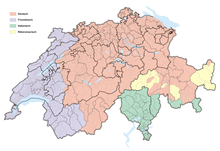
Switzerland has four national languages: mainly German (spoken natively by 62.8% of the population in 2016); French (22.9%) spoken natively in the west; and Italian (8.2%) spoken natively in the south.[216][215] The fourth national language, Romansh (0.5%), is a Romance language spoken locally in the southeastern trilingual canton of Grisons, and is designated by Article 4 of the Federal Constitution as a national language along with German, French, and Italian. In Article 70 it is mentioned as an official language if the authorities communicate with persons who speak Romansh. However, federal laws and other official acts do not need to be decreed in Romansh.
In 2016, the languages most spoken at home among permanent residents aged 15 and older were Swiss German (59.4%), French (23.5%), Standard German (10.6%), and Italian (8.5%). Other languages spoken at home included English (5.0%), Portuguese (3.8%), Albanian (3.0%), Spanish (2.6%) and Serbian and Croatian (2.5%). 6.9% reported speaking another language at home.[217] In 2014 almost two-thirds (64.4%) of the permanent resident population indicated speaking more than one language regularly.[218]
The federal government is obliged to communicate in the official languages, and in the federal parliament simultaneous translation is provided from and into German, French and Italian.[219]
Aside from the official forms of their respective languages, the four linguistic regions of Switzerland also have local dialectal forms. The role played by dialects in each linguistic region varies dramatically: in German-speaking regions, Swiss German dialects have become more prevalent since the second half of the 20th century, especially in the media, and are used as an everyday language for many, while the Swiss variety of Standard German is almost always used instead of dialect for written communication (c.f. diglossic usage of a language).[220] Conversely, in the French-speaking regions, local Franco-Provençal dialects have almost disappeared (only 6.3% of the population of Valais, 3.9% of Fribourg, and 3.1% of Jura still spoke dialects at the end of the 20th century), while in the Italian-speaking regions, the use of Lombard dialects is mostly limited to family settings and casual conversation.[220]
The principal official languages have terms not used outside of Switzerland, known as Helvetisms. German Helvetisms are, roughly speaking, a large group of words typical of Swiss Standard German that do not appear in Standard German, nor in other German dialects. These include terms from Switzerland's surrounding language cultures (German Billett[221] from French), from similar terms in another language (Italian azione used not only as act but also as discount from German Aktion).[222] Swiss French, while generally close to the French of France, also contains some Helvetisms. The most frequent characteristics of Helvetisms are in vocabulary, phrases, and pronunciation, although certain Helvetisms denote themselves as special in syntax and orthography. Duden, the comprehensive German dictionary, contains about 3000 Helvetisms.[222] Current French dictionaries, such as the Petit Larousse, include several hundred Helvetisms; notably, Swiss French uses different terms than that of France for the numbers 70 (septante) and 90 (nonante) and often 80 (huitante) as well.[223]
Learning one of the other national languages is compulsory for all Swiss pupils, hence many Swiss are supposed to be at least bilingual, especially those belonging to linguistic minority groups.[224] Because the largest part of Switzerland is German-speaking, many French, Italian, and Romansh speakers migrating to the rest of Switzerland and the children of those non-German-speaking Swiss born within the rest of Switzerland speak German. While learning one of the other national languages at school is important, most Swiss learn English to communicate with Swiss speakers of other languages, as it is perceived as a neutral means of communication. English often functions as the de facto lingua franca.[225]
Health
Swiss residents are required to buy health insurance from private insurance companies, which in turn are required to accept every applicant. While the cost of the system is among the highest, its health outcomes compare well with other European countries; patients have been reported as in general, highly satisfied with it.[226][227][228] In 2012, life expectancy at birth was 80.4 years for men and 84.7 years for women[229] – the world's highest.[230][231] However, spending on health at 11.4% of GDP (2010) is on par with Germany and France (11.6%) and other European countries, but notably less than the US (17.6%).[232] From 1990, costs steadily increased.[233]
It is estimated that one out of six Swiss persons suffers from mental illness.[234]
According to a survey conducted by Addiction Switzerland, fourteen per cent of men and 6.5% of women between 20 and 24 reported consuming cannabis in the past 30 days in 2020, and 4 Swiss cities were listed among the top 10 European cities for cocaine use as measured in wastewater, down from 5 in 2018.[235][236]
Culture
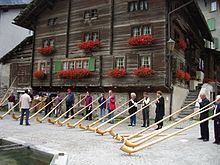
Swiss culture is characterised by diversity, which is reflected in diverse traditional customs.[237] A region may be in some ways culturally connected to the neighbouring country that shares its language, all rooted in western European culture.[238] The linguistically isolated Romansh culture in Graubünden in eastern Switzerland constitutes an exception. It survives only in the upper valleys of the Rhine and the Inn and strives to maintain its rare linguistic tradition.
Switzerland is home to notable contributors to literature, art, architecture, music and sciences. In addition, the country attracted creatives during times of unrest or war.[239] Some 1000 museums are found in the country.[237]
Among the most important cultural performances held annually are the Paléo Festival, Lucerne Festival,[240] the Montreux Jazz Festival,[241] the Locarno International Film Festival and Art Basel.[242]
Alpine symbolism played an essential role in shaping Swiss history and the Swiss national identity.[23][243] Many alpine areas and ski resorts attract visitors for winter sports as well as hiking and mountain biking in summer. The quieter seasons are spring and autumn. A traditional pastoral culture predominates in many areas, and small farms are omnipresent in rural areas. Folk art is nurtured in organisations across the country. Switzerland most directly in appears in music, dance, poetry, wood carving, and embroidery. The alphorn, a trumpet-like musical instrument made of wood has joined yodeling and the accordion as epitomes of traditional Swiss music.[244][245]
Religion
Religion in Switzerland (age 15+, 2018–2020):[246][k]
Christianity is the predominant religion according to national surveys of Swiss Federal Statistical Office[k] (about 67% of resident population in 2016–2018[3] and 75% of Swiss citizens[248]), divided between the Catholic Church (35.8% of the population), the Swiss Reformed Church (23.8%), further Protestant churches (2.2%), Eastern Orthodoxy (2.5%), and other Christian denominations (2.2%).[3]
Switzerland has no official state religion, though most of the cantons (except Geneva and Neuchâtel) recognise official churches, either the Catholic Church or the Swiss Reformed Church. These churches, and in some cantons the Old Catholic Church and Jewish congregations, are financed by official taxation of members.[249] In 2020, the Roman Catholic Church had 3,048,475 registered and church tax paying members (corresponding to 35.2% of the total population), while the Swiss Reformed Church had 2,015,816 members (23.3% of the total population).[250][l]
26.3% of Swiss permanent residents are not affiliated with a religious community.[3]
As of 2020, according to a national survey conducted by the Swiss Federal Statistical Office,[k] Christian minority communities included Neo-Pietism (0.5%), Pentecostalism (0.4%, mostly incorporated in the Schweizer Pfingstmission), Apostolic communities (0.3%), other Protestant denominations (1.1%, including Methodism), the Old Catholic Church (0.1%), other Christian denominations (0.3%). Non-Christian religions are Islam (5.3%),[3] Hinduism (0.6%), Buddhism (0.5%), Judaism (0.25%) and others (0.4%).[246]
Historically, the country was about evenly balanced between Catholic and Protestant, in a complex patchwork. During the Reformation Switzerland became home to many reformers. Geneva converted to Protestantism in 1536, just before John Calvin arrived. In 1541, he founded the Republic of Geneva on his own ideals. It became known internationally as the Protestant Rome and housed such reformers as Theodore Beza, William Farel or Pierre Viret. Zurich became another reform stronghold around the same time, with Huldrych Zwingli and Heinrich Bullinger taking the lead. Anabaptists Felix Manz and Conrad Grebel also operated there. They were later joined by the fleeing Peter Martyr Vermigli and Hans Denck. Other centres included Basel (Andreas Karlstadt and Johannes Oecolampadius), Bern (Berchtold Haller and Niklaus Manuel), and St. Gallen (Joachim Vadian). One canton, Appenzell, was officially divided into Catholic and Protestant sections in 1597. The larger cities and their cantons (Bern, Geneva, Lausanne, Zurich and Basel) used to be predominantly Protestant. Central Switzerland, the Valais, the Ticino, Appenzell Innerrhodes, the Jura, and Fribourg are traditionally Catholic.
The Swiss Constitution of 1848, under the recent impression of the clashes of Catholic vs Protestant cantons that culminated in the Sonderbundskrieg, consciously defines a consociational state, allowing the peaceful co-existence of Catholics and Protestants.[citation needed] A 1980 initiative calling for the complete separation of church and state was rejected by 78.9% of the voters.[251] Some traditionally Protestant cantons and cities nowadays have a slight Catholic majority, because since about 1970 a steadily growing minority were not affiliated with any religious body (21.4% in Switzerland, 2012) especially in traditionally Protestant regions, such as Basel-City (42%), canton of Neuchâtel (38%), canton of Geneva (35%), canton of Vaud (26%), or Zurich city (city: >25%; canton: 23%).[252]
Literature

The earliest forms of literature were in German, reflecting the language's early predominance. In the 18th century, French became fashionable in Bern and elsewhere, while the influence of the French-speaking allies and subject lands increased.[253]
Among the classic authors of Swiss literature are Jeremias Gotthelf (1797–1854) and Gottfried Keller (1819–1890); later writers are Max Frisch (1911–1991) and Friedrich Dürrenmatt (1921–1990), whose Das Versprechen (The Pledge) was released as a Hollywood film in 2001.[254]
Famous French-speaking writers were Jean-Jacques Rousseau (1712–1778) and Germaine de Staël (1766–1817). More recent authors include Charles Ferdinand Ramuz (1878–1947), whose novels describe the lives of peasants and mountain dwellers, set in a harsh environment, and Blaise Cendrars (born Frédéric Sauser, 1887–1961).[254] Italian and Romansh-speaking authors also contributed to the Swiss literary landscape, generally in proportion to their number.
Probably the most famous Swiss literary creation, Heidi, the story of an orphan girl who lives with her grandfather in the Alps, is one of the most popular children's books and has come to be a symbol of Switzerland. Her creator, Johanna Spyri (1827–1901), wrote a number of books on similar themes.[254]
Media
This section needs additional citations for verification. (February 2024) |
Freedom of the press and the right to free expression is guaranteed in the constitution.[255] The Swiss News Agency (SNA) broadcasts information in three of the four national languages—on politics, economics, society and culture. The SNA supplies almost all Swiss media and foreign media with its reporting.[255]
In Switzerland, the most influential newspapers include the German-language Tages-Anzeiger and Neue Zürcher Zeitung, as well as the French-language Le Temps. Additionally, almost every city has at least one local newspaper published in the predominant local language.[256][257]
The government exerts greater control over broadcast media than print media, especially due to financing and licensing.[citation needed] The Swiss Broadcasting Corporation, whose name was recently changed to SRG SSR, is charged with the production and distribution of radio and television content. SRG SSR studios are distributed across the various language regions. Radio content is produced in six central and four regional studios while video media are produced in Geneva, Zurich, Basel, and Lugano. An extensive cable network allows most Swiss to access content from neighbouring countries.[citation needed]
Sports
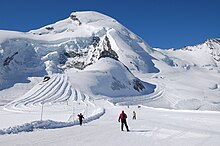
Skiing, snowboarding and mountaineering are among the most popular sports, reflecting the nature of the country[258] Winter sports are practised by natives and visitors. The bobsleigh was invented in St. Moritz.[259] The first world ski championships were held in Mürren (1931) and St. Moritz (1934). The latter town hosted the second Winter Olympic Games in 1928 and the fifth edition in 1948. Among its most successful skiers and world champions are Pirmin Zurbriggen and Didier Cuche.
The most prominently watched sports in Switzerland are football and ice hockey.[260]
The headquarters of the international football's and ice hockey's governing bodies, the International Federation of Association Football (FIFA) and International Ice Hockey Federation (IIHF) are located in Zurich. Many other headquarters of international sports federations are located in Switzerland. For example, the International Olympic Committee (IOC), IOC's Olympic Museum and the Court of Arbitration for Sport (CAS) are located in Lausanne.
Switzerland hosted the 1954 FIFA World Cup and was the joint host, with Austria, of the UEFA Euro 2008 tournament. The Swiss Super League is the nation's professional football club league. Europe's highest football pitch, at 2,000 metres (6,600 ft) above sea level, is located in Switzerland, the Ottmar Hitzfeld Stadium.[261]
Many Swiss follow ice hockey and support one of the 12 teams of the National League, which is the most attended league in Europe.[262] In 2009, Switzerland hosted the IIHF World Championship for the tenth time.[263] It also became World Vice-Champion in 2013 and 2018. Its numerous lakes make Switzerland an attractive sailing destination. The largest, Lake Geneva, is the home of the sailing team Alinghi which was the first European team to win the America's Cup in 2003 and which successfully defended the title in 2007.

Swiss tennis player Roger Federer is widely regarded as among the sport's greatest players. He won 20 Grand Slam tournaments overall including a record 8 Wimbledon titles. He won six ATP Finals.[265] He was ranked no. 1 in the ATP rankings for a record 237 consecutive weeks. He ended 2004, 2005, 2006, 2007 and 2009 ranked no. 1. Fellow Swiss players Martina Hingis and Stan Wawrinka also won multiple Grand Slam titles. Switzerland won the Davis Cup title in 2014.
Motorsport racecourses and events were banned in Switzerland following the 1955 Le Mans disaster with exceptions for events such as hillclimbing. The country continued to produce successful racing drivers such as Clay Regazzoni, Sébastien Buemi, Jo Siffert, Dominique Aegerter, successful World Touring Car Championship driver Alain Menu, 2014 24 Hours of Le Mans winner Marcel Fässler and 2015 24 Hours Nürburgring winner Nico Müller. Switzerland also won the A1GP World Cup of Motorsport in 2007–08 with driver Neel Jani. Swiss motorcycle racer Thomas Lüthi won the 2005 MotoGP World Championship in the 125cc category. In June 2007 the Swiss National Council, one house of the Federal Assembly of Switzerland, voted to overturn the ban, however the other house, the Swiss Council of States rejected the change and the ban remains in place.[266][267]
Traditional sports include Swiss wrestling or Schwingen, a tradition from the rural central cantons and considered the national sport by some. Hornussen is another indigenous Swiss sport, which is like a cross between baseball and golf.[268] Steinstossen is the Swiss variant of stone put, a competition in throwing a heavy stone. Practised only among the alpine population since prehistoric times, it is recorded to have taken place in Basel in the 13th century. It is central to the Unspunnenfest, first held in 1805, with its symbol the 83.5 stone named Unspunnenstein.[269]
Cuisine

The cuisine is multifaceted. While dishes such as fondue, raclette or rösti are omnipresent, each region developed its gastronomy according to the varieties of climate and language, for example, Zürcher Geschnetzeltes, engl.: sliced meat Zurich style.[270] Traditional Swiss cuisine uses ingredients similar to those in other European countries, as well as unique dairy products and cheeses such as Gruyère or Emmental, produced in the valleys of Gruyères and Emmental. The number of fine-dining establishments is high, particularly in western Switzerland.[271][272]
Chocolate has been made in Switzerland since the 18th century. Its reputation grew at the end of the 19th century with the invention of modern techniques such as conching and tempering, which enabled higher quality. Another breakthrough was the invention of solid milk chocolate in 1875 by Daniel Peter. The Swiss are the world's largest chocolate consumers.[273][274]
The most popular alcoholic drink is wine. Switzerland is notable for its variety of grape varieties, reflecting the large variations in terroirs. Swiss wine is produced mainly in Valais, Vaud (Lavaux), Geneva and Ticino, with a small majority of white wines. Vineyards have been cultivated in Switzerland since the Roman era, even though traces of a more ancient origin can be found. The most widespread varieties are the Chasselas (called Fendant in Valais) and Pinot Noir. Merlot is the main variety produced in Ticino.[275][276]
See also
Notes
- ^ a b Bern is referred to as "federal city" (German: Bundesstadt; French: ville fédérale; Italian: città federale; Romansh: citad federala). Swiss law does not designate a capital as such, but the federal parliament and government are installed in Bern, while other federal institutions, such as the federal courts, are in other cities (Bellinzona, Lausanne, Lucerne, Neuchâtel, St. Gallen a.o.).
- ^ Traditional date. The original date of the Rütli Oath was 1307 (reported by Aegidius Tschudi in the 16th century) and is just one among several comparable treaties between more or less the same parties during that period. The date of the Federal Charter of 1291 was selected in 1891 for the official celebration of the "Confederacy's 600th anniversary".
- ^ A solemn declaration of the Tagsatzung declared the Federal Constitution adopted on 12 September 1848. A resolution of the Tagsatzung of 14 September 1848 specified that the powers of the institutions provided for by the 1815 Federal Treaty would expire at the time of the constitution of the Federal Council, which took place on 16 November 1848.
- ^ There are several definitions. See Geography of Switzerland#Western or Central Europe.
- ^ Formerly the Christian Democratic People's Party (CVP/PCD), which merged with the BDP party to form the Centre party in 2019
- ^ Since 1999, an initiative can also be in the form of a general proposal to be elaborated by Parliament. Still, because it is considered less attractive for various reasons, this initiative has yet to be used
- ^ That is a majority of 23 cantonal votes because the result of the popular vote in the six traditional half-cantons each counts as half the vote of one of the other cantons.
- ^ Assumption made in the study: one third of the shares is "not allocable" and has been distributed equally among current regions.
- ^ In 2008, the ETH Zurich was ranked 15th in the field Natural Sciences and Mathematics by the Shanghai Academic Ranking of World Universities and the EPFL in Lausanne was ranked 18th in the field Engineering/Technology and Computer Sciences by the same ranking.
- ^ Nobel prizes in non-science categories included.
- ^ a b c Since 2010, statistics of religious affiliation in Switzerland provided by the Swiss Federal Statistical Office are based on a national structural survey of 200,000 people aged 15 years and older (corresponding to 2.5% of the total resident population). Data are extrapolated to obtain statistical results for the whole population (aged 15 years and older). These results are estimates subject to some degree of uncertainty indicated by a confidence interval, but by merging samples (pooling) from several years it is possible to get more accurate results, including total number of Protestants and information about minority religions. Note: The figures of the structural survey are not entirely comparable to data collection before 2010 based on census figures (counting every person living in Switzerland) or to annual official numbers of church members.[247]
- ^ Precise statistics about the membership of churches among the total population in Switzerland is only available for officially registered and church tax paying members of the Catholic Church in Switzerland and the Protestant Church of Switzerland (Landeskirchen).
References
- ^ a b c d Georg Kreis: Federal city in German, French and Italian in the online Historical Dictionary of Switzerland, 20 March 2015.
- ^ a b Holenstein, André (2012). "Die Hauptstadt existiert nicht". UniPress – Forschung und Wissenschaft an der Universität Bern (scientific article) (in German). 152 (Sonderfall Hauptstatdtregion). Bern: Department Communication, University of Bern: 16–19. doi:10.7892/boris.41280. S2CID 178237847.
Als 1848 ein politisch-administratives Zentrum für den neuen Bundesstaat zu bestimmen war, verzichteten die Verfassungsväter darauf, eine Hauptstadt der Schweiz zu bezeichnen und formulierten stattdessen in Artikel 108: "Alles, was sich auf den Sitz der Bundesbehörden bezieht, ist Gegenstand der Bundesgesetzgebung." Die Bundesstadt ist also nicht mehr und nicht weniger als der Sitz der Bundesbehörden.
[In 1848, when a political and administrative centre was being determined for the new federation, the founders of the constitution abstained from designating a capital city for Switzerland and instead formulated in Article 108: "Everything, which relates to seat of the authorities, is the subject of the federal legislation." The federal city is therefore no more and no less than the seat of the federal authorities.] - ^ a b c d e "Religions". Neuchâtel, Switzerland: Federal Statistical Office. Archived from the original on 12 September 2024. Retrieved 30 October 2024.
- ^ Shugart, Matthew Søberg (December 2005). "Semi-Presidential Systems: Dual Executive And Mixed Authority Patterns". French Politics. 3 (3): 323–351. doi:10.1057/palgrave.fp.8200087. ISSN 1476-3419. S2CID 73642272.
- ^ Elgie, Robert (2016). "Government Systems, Party Politics, and Institutional Engineering in the Round". Insight Turkey. 18 (4): 79–92. ISSN 1302-177X. JSTOR 26300453.
- ^ Kley, Andreas: Federal constitution in German, French and Italian in the online Historical Dictionary of Switzerland, 3 May 2011.
- ^ "Surface water and surface water change". Organisation for Economic Co-operation and Development (OECD). Archived from the original on 24 March 2021. Retrieved 11 October 2020.
- ^ "Bevölkerungsstand am Ende des 2. Quartals 2023 | Bundesamt für Statistik". 20 September 2023. Archived from the original on 20 September 2023. Retrieved 20 September 2023.
- ^ Jacqueline Kucera; Athena Krummenacher, eds. (22 November 2016). Switzerland's population 2015 (PDF) (Report). Swiss Statistics. Neuchâtel, Switzerland: Swiss Federal Statistical Office (FSO), Swiss Confederation. Archived from the original on 20 December 2016. Retrieved 7 December 2016.
- ^ a b c d "World Economic Outlook Database, October 2024 Edition. (Switzerland)". www.imf.org. International Monetary Fund. 22 October 2024. Retrieved 22 October 2024.
- ^ "Gini coefficient of equivalised disposable income – EU-SILC survey". ec.europa.eu. Eurostat. Archived from the original on 9 October 2020. Retrieved 31 March 2024.
- ^ "Human Development Report 2023/2024" (PDF). United Nations Development Programme. 13 March 2024. Archived (PDF) from the original on 13 March 2024. Retrieved 13 March 2024.
- ^ Berner, Elizabeth Kay; Berner, Robert A. (22 April 2012). Global Environment: Water, Air, and Geochemical Cycles – Second Edition. Princeton University Press. ISBN 978-1-4008-4276-6. Archived from the original on 22 September 2023. Retrieved 23 August 2020.
- ^ a b "BFS: 9 Millionen Menschen in der Schweiz – 20 Minuten". 20 September 2023. Archived from the original on 22 September 2023. Retrieved 20 September 2023.
- ^ Thomas Fleiner; Alexander Misic; Nicole Töpperwien (5 August 2005). Swiss Constitutional Law. Kluwer Law International. p. 28. ISBN 978-90-411-2404-3. Archived from the original on 12 April 2023. Retrieved 25 July 2023.
- ^ "Global wealth databook 2019" (PDF). Credit Suisse. Archived from the original (PDF) on 23 October 2019. Retrieved 17 June 2020.Archived . The country data comes from Table 3.1 on page 117. The region data comes from the end of that table on page 120.
- ^ Ghosh, Subir (9 October 2010). "US is still by far the richest country, China fastest growing". Digital Journal. Archived from the original on 12 January 2016. Retrieved 14 December 2015.
- ^ Bowers, Simon (19 October 2011). "Franc's rise puts Swiss top of rich list". The Guardian. London. Archived from the original on 12 January 2016. Retrieved 14 December 2015.
- ^ Bachmann, Helena (23 March 2018). "Looking for a better quality of life? Try these three Swiss cities". USA Today. Archived from the original on 9 November 2020. Retrieved 14 January 2021.
- ^ Taylor, Chloe (20 May 2019). "These cities offer the best quality of life in the world, according to Deutsche Bank". CNBC. Archived from the original on 23 June 2019. Retrieved 14 January 2021.
- ^ "Coronavirus: Paris and Zurich become world's most expensive cities to live in because of COVID-19". Euronews. 18 November 2020. Archived from the original on 12 December 2020. Retrieved 14 January 2021.
- ^ Vatter, Adrian (2014). Das politische System der Schweiz [The Political System of Switzerland]. Studienkurs Politikwissenschaft (in German). Baden-Baden: UTB Verlag. ISBN 978-3-8252-4011-0. Archived from the original on 22 December 2015. Retrieved 20 December 2015.
- ^ a b Zimmer, Oliver (12 January 2004) [originally published: October 1998]. "In Search of Natural Identity: Alpine Landscape and the Reconstruction of the Swiss Nation". Comparative Studies in Society and History. 40 (4). London: 637–665. doi:10.1017/S0010417598001686 (inactive 1 August 2024). S2CID 146259022.
{{cite journal}}: CS1 maint: DOI inactive as of August 2024 (link) - ^ Lang, Josef (14 December 2015). "Die Alpen als Ideologie". Tages-Anzeiger (in German). Zurich, Switzerland. Archived from the original on 15 December 2015. Retrieved 14 December 2015.
- ^ Schmock, Nico (30 January 2019). Die Schweiz als "Willensnation"? Die Kernelemente des Schweizer Selbstverständnisses (in German). GRIN Verlag. ISBN 978-3-668-87199-1. Archived from the original on 22 January 2023. Retrieved 4 June 2022.
- ^ "swiss | Etymology, origin and meaning of swiss by etymonline". www.etymonline.com. Archived from the original on 30 April 2011. Retrieved 15 September 2022.
- ^ Room, Adrian (2003). Placenames of the world : origins and meanings of the names for over 5000 natural features, countries, capitals, territories, cities, and historic sites. Jefferson, N.C.: McFarland. ISBN 978-0-7864-1814-5. OCLC 54385937.
- ^ "Switzerland". Catholic Encyclopedia. New Advent. Archived from the original on 22 January 2010. Retrieved 15 September 2022.
- ^ "On Schwyzers, Swiss and Helvetians". admin.ch. Archived from the original on 5 August 2010.
- ^ "Züritütsch, Schweizerdeutsch" (PDF). schweizerdeutsch.ch. p. 2. Archived from the original (PDF) on 12 January 2016. Retrieved 26 January 2010.
- ^ "Kanton Schwyz: Kurzer historischer Überblick". sz.ch. Archived from the original on 15 August 2016. Retrieved 26 January 2010.
- ^ "Confoederatio helvetica (CH)". hls-dhs-dss.ch (in German). Archived from the original on 27 September 2015. Retrieved 15 September 2022., Historical Lexicon of Switzerland.
- ^ Helvetia in German, French and Italian in the online Historical Dictionary of Switzerland.
- ^ a b c d e f g h "History". swissworld.org. Archived from the original on 19 April 2010. Retrieved 27 June 2009.
- ^ "Switzerland's Roman heritage comes to life". swissinfo.ch. 11 September 2005. Archived from the original on 15 September 2022. Retrieved 15 September 2022.
- ^ Trumm, Judith. "Vindonissa". Historical Dictionary of Switzerland (in German). Archived from the original on 3 May 2022. Retrieved 3 May 2022.
- ^ a b Zschokke, Heinrich; Zschokke, Emil; Shaw, Francis George (1855). The history of Switzerland, for the Swiss people. New York Public Library. New York, C. S. Francis & Co.; London, S. Low, Son & Co. pp. 22–24.
- ^ a b c d "Switzerland history". Nations Encyclopedia. Archived from the original on 1 March 2014. Retrieved 27 November 2009.
- ^ a b c d e f g "Brief History of Switzerland". Nations Online. Archived from the original on 8 May 2014. Retrieved 27 November 2009.
- ^ Greanias, Thomas (2004). Geschichte der Schweiz und der Schweizer. Basel: Schwabe. ISBN 978-3-7965-2067-9. OCLC 255970548.
- ^ a b c d e f g h i j k l m n o p "A Brief Survey of Swiss History". Federal Department of Foreign Affairs. Archived from the original on 26 June 2009. Retrieved 22 June 2009.
- ^ "Der Basler Bundesbrief vom 9. Juni 1501" (PDF). Archived (PDF) from the original on 14 May 2022. Retrieved 3 May 2022.
- ^ E.Hofer, Roland. "Schaffhausen (Kanton)". Historical Dictionary of Switzerland (in German). Archived from the original on 3 May 2022. Retrieved 3 May 2022.
- ^ Bertholet, Auguste; Kapossy, Béla (2023). La Physiocratie et la Suisse (in French). Geneva: Slatkine. ISBN 9782051029391.
- ^ Linder, Wolf; Vatter, Adrian (2001). "Institutions and outcomes of Swiss federalism: The role of the cantons in Swiss politics". West European Politics. 24 (2): 95. doi:10.1080/01402380108425435. ISSN 0140-2382. Archived from the original on 22 June 2023. Retrieved 11 June 2024.
- ^ Swiss border ("Les principales rectifications postérieures à 1815 concernent la vallée des Dappes en 1862 (frontière Vaud-France, env. 7,5 km2), la valle di Lei en 1952 (Grisons-Italie, 0,45 km2), l'Ellhorn en 1955 (colline revendiquée par la Suisse pour des raisons militaires, Grisons-Liechtenstein) et l'enclave allemande du Verenahof dans le canton de Schaffhouse en 1967.") in German, French and Italian in the online Historical Dictionary of Switzerland.. It should be noticed that in valle di Lei, Italy got in exchange a territory of the same area. See here Archived 21 May 2014 at the Wayback Machine
- ^ "Noblesse en Suisse". Archived from the original on 3 March 2016. Retrieved 22 October 2015.
- ^ "The WIR, the supplementary Swiss currency since 1934". The Economy Journal. Archived from the original on 12 June 2021. Retrieved 12 June 2021.
- ^ Ducrest, Jean Pierre; Dorand, Michel (1987). Histoire de la Suisse. Editions Fragnière. OCLC 702317703.
- ^ "Lenin and the Swiss non-revolution". SWI swissinfo.ch. 19 May 2006. Archived from the original on 8 February 2023. Retrieved 8 February 2023.
- ^ a b van Ginneken, Anique H. M. (2006). Historical Dictionary of the League of Nations. Scarecrow Press. p. 182. ISBN 9780810865136.
- ^ Urner, Klaus (2002). "Let's Swallow Switzerland": Hitler's Plans against the Swiss Confederation. Lanham, Maryland: Lexington Books. pp. 4, 7. ISBN 978-0-7391-0255-8. OCLC 46472272.
- ^ a b c "Book Review: Halbrook, Stephen P. Target Switzerland: Swiss Armed Neutrality in World War II. Rockville Centre, NY: Sarpedon, 1998". Stone & Stone. Archived from the original on 1 December 2009. Retrieved 2 December 2009.
- ^ a b Asylum in German, French and Italian in the online Historical Dictionary of Switzerland.
- ^ a b c d Final Report of the Independent Commission of Experts Switzerland (PDF). Zurich: Pendo Verlag. 2002. ISBN 978-3-85842-603-1. Archived (PDF) from the original on 30 May 2009.
- ^ Helmreich, JE. "Diplomacy of Apology". Archived from the original on 5 May 2007. Retrieved 5 May 2007.
- ^ "States Formerly Possessing or Pursuing Nuclear Weapons". Archived from the original on 26 January 2015. Retrieved 6 March 2014.
- ^ Fischer, Patrick (8 April 2019). "Als die Schweiz eine Atombombe wollte". Swiss National Museum (in German). Archived from the original on 11 May 2022. Retrieved 3 May 2022.
- ^ Vuilleumier, Marie (15 October 2018). "Paul Scherrer Institut seit 30 Jahren im Dienst der Wissenschaft". Swissinfo (in German). Archived from the original on 3 May 2022. Retrieved 3 May 2022.
- ^ Westberg, Gunnar (9 October 2010). "Swiss Nuclear Bomb". International Physicians for the Prevention of Nuclear War. Archived from the original on 5 March 2014. Retrieved 6 March 2014.
- ^ a b c "Country Profile: Switzerland". Foreign & Commonwealth Office. 19 October 2012. Archived from the original on 16 January 2013. Retrieved 8 February 2023.
- ^ "Parlamentsgeschichte". www.parlament.ch. Archived from the original on 3 May 2022. Retrieved 3 May 2022.
- ^ Henley, Jon (25 September 2020). "Swiss to vote on whether to end free movement deal with EU". The Guardian. Archived from the original on 25 September 2020. Retrieved 25 September 2020.
- ^ Chazan, David (27 September 2020). "Large majority of Swiss reject bid to rein in immigration from EU, says exit poll". The Telegraph. Archived from the original on 10 January 2022. Retrieved 27 September 2020.
- ^ "Abstimmungen – Indikatoren, Abstimmung vom 9. Februar 2014: Initiative 'Gegen Masseneinwanderung'" (in German and French). Swiss Federal Statistical Office, Neuchâtel 2014. 9 February 2014. Archived from the original on 21 April 2014. Retrieved 20 April 2014.
- ^ Maurice, Eric (22 December 2016). "EU and Switzerland agree on free movement". EUobserver. Archived from the original on 8 February 2023. Retrieved 8 February 2023.
- ^ "Switzerland referendum: Voters reject end to free movement with EU". BBC News. 27 September 2020. Archived from the original on 28 September 2020. Retrieved 8 February 2023.
- ^ a b c d e "Swiss Geography". swissworld.org. Presence Switzerland, Federal Department of Foreign Affairs. Archived from the original on 8 October 2014. Retrieved 12 October 2014.
- ^ "Map Gallery Switzerland: Physical Geography of Switzerland". Neuchâtel, Switzerland: Swiss Federal Statistical Office. Archived from the original on 13 October 2014. Retrieved 12 October 2014.
- ^ Mauch, Corine; Reynard, Emmanuel (2004), "The Evolution of the Water Regime in Switzerland", The Evolution of National Water Regimes in Europe, Dordrecht: Springer Netherlands, pp. 293–328, doi:10.1007/978-1-4020-2484-9_9, ISBN 978-90-481-6667-1, retrieved 9 August 2024
- ^ Winstral, Adam; Jonas, Tobias; Helbig, Nora (13 January 2017). "Statistical Downscaling of Gridded Wind Speed Data Using Local Topography". Journal of Hydrometeorology. 18 (2): 335–348. Bibcode:2017JHyMe..18..335W. doi:10.1175/jhm-d-16-0054.1. ISSN 1525-755X.
- ^ Enclaves of the world Archived 18 September 2009 at the Wayback Machine enclaves.webs.com. Retrieved on 15 December 2009
- ^ a b "Swiss Climate". Swiss Federal Office of Meteorology and Climatology MeteoSwiss, Swiss Federal Department of Home Affairs FDHA, Swiss Confederation. Archived from the original on 29 June 2007. Retrieved 12 October 2014.
- ^ a b "Swiss climate maps". Swiss Federal Office of Meteorology and Climatology MeteoSwiss, Swiss Federal Department of Home Affairs FDHA, Swiss Confederation. Archived from the original on 23 February 2010. Retrieved 12 October 2014.
- ^ Dinerstein, Eric; et al. (2017). "An Ecoregion-Based Approach to Protecting Half the Terrestrial Realm". BioScience. 67 (6): 534–545. doi:10.1093/biosci/bix014. ISSN 0006-3568. PMC 5451287. PMID 28608869.
- ^ "Environment: Impact of climate change". swissworld.org. Presence Switzerland, Federal Department of Foreign Affairs. Archived from the original on 15 November 2014. Retrieved 12 October 2014.
- ^ "2014 Environmental Performance Index". epi.yale.edu/epi. Yale Center for Environmental Law & Policy, Yale University, and Center for International Earth Science Information Network, Columbia University. 2014. Archived from the original on 29 January 2014. Retrieved 12 October 2014.
- ^ "2020 EPI Results". Environmental Performance Index. 3 June 2020. Archived from the original on 3 September 2021. Retrieved 20 November 2020.
- ^ Farand, Chloé (25 February 2020). "Switzerland reaffirms 2030 climate plan to UN, works on net zero 2050 goal". Climate Home News. Archived from the original on 24 November 2020. Retrieved 20 November 2020.
- ^ a b "Country Trends". Global Footprint Network. Archived from the original on 8 August 2017. Retrieved 17 October 2019.
- ^ Grantham, H. S.; et al. (2020). "Anthropogenic modification of forests means only 40% of remaining forests have high ecosystem integrity – Supplementary Material". Nature Communications. 11 (1): 5978. Bibcode:2020NatCo..11.5978G. doi:10.1038/s41467-020-19493-3. ISSN 2041-1723. PMC 7723057. PMID 33293507.
- ^ "2024 Environmental Performance Index". Environmental Performance Index. Retrieved 15 October 2024.
- ^ "2024 Environmental Performance Index - Switzerland". Environmental Performance Index. Retrieved 15 October 2024.
- ^ "Population – facts and figures". Federal Department of Foreign Affairs. Archived from the original on 17 April 2023. Retrieved 17 March 2023.
- ^ a b c d e "Städte und Agglomerationen unter der Lupe". Bundesamt für Raumentwicklung (in German). Archived from the original on 15 August 2010. Retrieved 26 June 2009.
- ^ Swiss countryside succumbs to urban sprawl Archived 16 March 2012 at the Wayback Machine swissinfo.ch. Retrieved on 30 June 2009
- ^ Enquête représentative sur l'urbanisation de la Suisse (Pronatura) Archived 30 April 2011 at the Wayback Machine gfs-zh.ch. Retrieved on 30 June 2009.
- ^ "Urban and rural areas". Federal Department of Foreign Affairs. Archived from the original on 17 April 2023. Retrieved 17 March 2023.
- ^ "Quality of Living City Ranking | Mercer". mobilityexchange.mercer.com. Archived from the original on 18 April 2018. Retrieved 4 July 2020.
- ^ a b c "Regionalportraits 2021: Cantons". Federal Statistical Office. Federal Department of Home Affairs FDHA. 17 March 2021. p. 79 (81 in PDF). Archived from the original on 15 July 2021. Retrieved 15 July 2021. Note: page number refers to report pagination; PDF viewer displays pages two numbers higher.
- ^ a b c d e f "Switzerland's political system". Bern, Switzerland: The Federal Council. Archived from the original on 20 June 2016. Retrieved 24 June 2016.
- ^ "Federalism". Bern, Switzerland: The Federal Council. Archived from the original on 14 July 2016. Retrieved 24 June 2016.
- ^ "Die Legislative ist ein Miliz-Parlament – SWI swissinfo.ch". 9 December 2009. Archived from the original on 20 December 2016. Retrieved 13 December 2016.
- ^ "The federal courts". Bern, Switzerland: The Federal Council. Archived from the original on 14 July 2016. Retrieved 24 June 2016.
- ^ a b Peter Knoepfel; Yannis Papadopoulos; Pascal Sciarini; Adrian Vatter; Silja Häusermann, eds. (2014). Handbuch der Schweizer Politik – Manuel de la politique suisse (in German and French) (5 ed.). Zurich, Switzerland: Verlag Neue Zürcher Zeitung, NZZ libro. ISBN 978-3-03823-866-9. Archived from the original on 14 July 2016. Retrieved 24 June 2016.
- ^ Andreas Gross: Popular rights in German, French and Italian in the online Historical Dictionary of Switzerland, 22 April 2015.
- ^ Kaufmann, Bruno (18 May 2007). "How direct democracy makes Switzerland a better place". The Telegraph. London, UK. Archived from the original on 7 December 2009. Retrieved 9 December 2009.
- ^ a b "Addresses of administrative authorities". Bern, Switzerland: ch.ch, A service of the Confederation, cantons and communes. Archived from the original on 14 July 2016. Retrieved 24 June 2016.
- ^ Andreas Würgler: Confederal Diet in German, French and Italian in the online Historical Dictionary of Switzerland, 25 September 2014.
- ^ "Bundesstadtstatus Stadt Bern" (official website) (in German, French, and Italian). Bern, Switzerland: Swiss Federal Chancellery. 13 July 2006. Archived from the original on 10 October 2017. Retrieved 11 May 2017.
- ^ a b c d e "Neutrality". Federal Department of Foreign Affairs. Archived from the original on 24 March 2023. Retrieved 17 March 2023.
- ^ "Switzerland – Country history and economic development". nationsencyclopedia.com. Archived from the original on 6 February 2010. Retrieved 12 December 2009.
- ^ Stephens, Thomas (12 February 2020). "Latest spy scandal 'shatters Swiss neutrality', say papers". SWI swissinfo.ch. Archived from the original on 2 March 2020. Retrieved 16 March 2020.
- ^ "ICRC in WW II: the Holocaust". Archived from the original on 4 September 2012. Retrieved 28 August 2012..
- ^ "Schengen Visa Countries List – Schengen Area". Schengen VISA Information. Archived from the original on 4 December 2015. Retrieved 4 December 2015.
- ^ "The Nobel Peace Prize 1901". NobelPrize.org. Archived from the original on 8 February 2023. Retrieved 8 February 2023.
- ^ Sports directory Archived 3 May 2010 at the Wayback Machine if-sportsguide.ch. Retrieved on 25 January 2010
- ^ "Switzerland elected to UN Security Council". SWI swissinfo.ch. 9 June 2022. Archived from the original on 9 June 2022. Retrieved 9 June 2022.
- ^ "2024 Global Peace Index" (PDF).
- ^ "Volksinitiative "Ja zu Europa!"" [Initiative "Yes to Europe!"] (PDF) (in German). BFS/OFS/UST. 13 February 2003. Archived from the original (PDF) on 24 June 2008. Retrieved 15 June 2008.
- ^ "Volksinitiative "Ja zu Europa!", nach Kantonen. (Initiative "Yes to Europe!" by Canton)" (in German). BFS/OFS/UST. 16 January 2003. Archived from the original (XLS) on 1 May 2011. Retrieved 15 June 2008.
- ^ "Bilateral agreements Switzerland-EU". www.europa.admin.ch. Swiss Directorate for European Affairs DEA, Federal Department of Foreign Affairs FDFA. Archived from the original on 30 August 2014. Retrieved 8 May 2014.
- ^ Switzerland and the European Union Archived 15 August 2010 at the Wayback Machine europa.admin.ch. Retrieved on 25 January 2010.
- ^ Switzerland in Schengen: end to passport checks Archived 23 May 2009 at the Wayback Machine euronews.net. Retrieved on 25 January 2010.
- ^ "Volksinitiative "Für den Schutz vor Waffengewalt" Home". 1 March 2009. Archived from the original on 1 March 2009. Retrieved 8 February 2023.
- ^ "Militärdiestpflicht" (in German, French, and Italian). Swiss Federal Department of Defence, Civil Protection and Sport. Archived from the original on 13 December 2013. Retrieved 15 January 2014.
- ^ "Zwei Drittel der Rekruten diensttauglich (Schweiz, NZZ Online)". Neue Zürcher Zeitung. Associated Press. 11 March 2008. Archived from the original on 4 March 2021. Retrieved 23 February 2009.
- ^ "VBS – Die Armee in Zahlen – Truppenbestände". Archived from the original on 9 September 2009. Retrieved 8 February 2023.
- ^ "Weiterentwicklung der Armee" (in German). Swiss Armed Forces. Archived from the original on 20 April 2021. Retrieved 30 April 2021.
- ^ "Weiterentwicklung der Armee-FAQ (Politik)" (Click to expand the question 'Wie verändert sich der Sollbestand der Armee?'). Schweizer Armee (in German). Archived from the original on 7 May 2023. Retrieved 17 April 2023.
- ^ "Swiss order biggest military mobilization since WWII to fight virus". Reuters. 16 March 2020. Archived from the original on 27 November 2023. Retrieved 22 October 2023.
- ^ Chapin, Emerson (2 September 1990). "Edwin Reischauer, Diplomat and Scholar, Dies at 79". The New York Times. ISSN 0362-4331. Archived from the original on 25 March 2020. Retrieved 8 February 2023.
- ^ "Guns in Switzerland – Firearms, gun law and gun control". www.gunpolicy.org. Archived from the original on 24 April 2021. Retrieved 30 April 2021.
- ^ "Global Firearms Holdings Dynamic Map". smallarmssurvey.org. Geneva, Switzerland: Institut de hautes études internationales et du développement. June 2018. Archived from the original on 10 July 2018. Retrieved 9 July 2018.
- ^ "Die Armee in Zahlen" (in German, French, and Italian). The Swiss Federal Council. Archived from the original on 5 February 2020. Retrieved 30 April 2021.
- ^ "SR 514.101 Verordnung des VBS über die persönliche Ausrüstung der Armeeangehörigen (VPAA-VBS) vom 9. Dezember 2003 (Stand am 1. Januar 2015): Art. 7 Taschenmunition Ziff 1" (in German, French, and Italian). The Swiss Federal Council. 21 December 2007. Archived from the original on 28 December 2016. Retrieved 6 December 2016.
- ^ "Soldiers can keep guns at home but not ammo". Swissinfo. 27 September 2007. Archived from the original on 7 December 2016. Retrieved 7 December 2016.
- ^ "City Mayors: World's most powerful cities". City Mayors. Archived from the original on 10 May 2012. Retrieved 8 February 2023.
- ^ "Credit Suisse: Global wealth has soared 14% since 2010 to USD 231 trillion with the strongest growth in emerging markets". Credit Suisse. Archived from the original on 24 July 2014. Retrieved 17 March 2023.
- ^ Table 2: Top 10 countries with the highest average wealth per adult in 2011 Archived 14 November 2012 at the Wayback Machine. Credit Suisse.
- ^ "Global Wealth Reaches New All-Time High". The Financialist. Credit Suisse. 9 October 2013. Archived from the original on 29 July 2016. Retrieved 10 October 2013.
- ^ "Switzerland, US 'The Most Corrupt'". Wall Street International Magazine. 9 February 2018.[permanent dead link]
- ^ Jörg, Aurel (7 February 2017). "Was wäre die Schweiz ohne die Pharma? | NZZ". Neue Zürcher Zeitung. Archived from the original on 21 October 2019. Retrieved 29 July 2020.
- ^ "Country Rankings: World & Global Economy Rankings on Economic Freedom". www.heritage.org. Archived from the original on 5 July 2018. Retrieved 29 July 2023.
- ^ "2023 Index of Economic Freedom: Switzerland". Index of Economic Freedom. The Heritage Foundation. Archived from the original on 8 February 2023. Retrieved 8 February 2023.
- ^ "GDP per capita By Country, in current US$ 2015-2022". World Integrated Trade Solution. World Bank. Retrieved 30 October 2024.
- ^ "GDP per capita, PPP By Country, in current international $ 2015-2022". World Integrated Trade Solution. World Bank. Retrieved 30 October 2024.
- ^ "Fewer Swiss shares: Foreign investors own 60% of Swiss corporations". Bern, Switzerland: swissinfo.ch – a SRG SSR Swiss Broadcasting Corporation. 4 April 2019. Archived from the original on 2 October 2020. Retrieved 12 February 2020.
- ^ "Global Competitiveness Report 2016–2017" (PDF). World Economic Forum. Archived (PDF) from the original on 26 February 2017.
- ^ "2019 Global Competitiveness Report 4.0". Geneva, Switzerland: WEF. 8 October 2019. Archived from the original on 2 June 2020. Retrieved 30 May 2020.
- ^ "European Innovation Scoreboard – European Commission". 5 July 2016. Archived from the original on 20 December 2016. Retrieved 13 December 2016.
- ^ Dutta, Soumitra; Lanvin, Bruno; Rivera León, Lorena; Wunsch-Vincent, Sacha (2024). Global Innovation Index 2024: Unlocking the Promise of Social Entrepreneurship. World Intellectual Property Organization. p. 18. doi:10.34667/tind.50062. ISBN 978-92-805-3681-2. Retrieved 6 October 2024.
- ^ Global Innovation Index 2023, 15th Edition. World Intellectual Property Organization. 18 April 2024. doi:10.34667/tind.46596. ISBN 978-92-805-3432-0. Archived from the original on 22 October 2023. Retrieved 17 October 2023.
- ^ Dutta, Soumitra; Lanvin, Bruno; León, Lorena Rivera; Wunsch-Vincent, eds. (2022). Global Innovation Index 2022, 15th Edition (PDF). World Intellectual Property Organization. doi:10.34667/tind.46596. ISBN 978-92-805-3432-0. Archived (PDF) from the original on 30 September 2022. Retrieved 16 November 2022.
- ^ Dutta, Soumitra; Lanvin, Bruno; León, Lorena Rivera; Wunsch-Vincent (eds.). "Global Innovation Index 2021". WIPO. Archived from the original on 20 November 2021.
- ^ a b "Policy Brief: Economic Survey of Switzerland, 2007" (PDF). OECD. Archived from the original (PDF; 326 KiB) on 24 June 2008.
- ^ Economic Policy Reforms: Going for Growth 2008 – Switzerland Country Note Archived 24 June 2009 at the Wayback Machine. Organisation for Economic Co-operation and Development (OECD), 2008, ISBN 978-92-64-04284-1
- ^ "The IMD World Talent Ranking 2020". Lausanne, Switzerland: IMD International Institute for Management Development. 1 March 2021. Archived from the original on 8 March 2021. Retrieved 1 March 2021.
- ^ Western Europe. Routledge. 2002. pp. 645–646. ISBN 978-1-85743-152-0.
- ^ a b c Wong Sak Hoi, Geraldine (29 July 2019). "Fact check: Are most Swiss residents rich?". SWI swissinfo.ch. Archived from the original on 15 September 2024. Retrieved 30 October 2024.
- ^ "Schweiz – Bruttoinlandsprodukt (BIP) pro Kopf nach Kantonen 2017". Statista. Archived from the original on 4 November 2018. Retrieved 8 June 2020.
- ^ a b c d Swiss Statistical Yearbook 2008 by Swiss Federal Statistical Office
- ^ "Six Swiss companies make European Top 100". swissinfo.ch. 18 October 2008. Retrieved 22 July 2008.
- ^ von Wy, Benjamin (4 March 2023). "Switzerland: the land of cooperatives". SWI swissinfo.ch. Illustration by Philip Schaufelberger. Archived from the original on 5 March 2023. Retrieved 5 March 2023.
- ^ Gabriel Zucman; Thomas Torslov; Ludvig Wier (June 2018). "The Missing Profits of Nations". National Bureau of Economic Research, Working Papers. p. 31. Archived from the original on 2 April 2019. Retrieved 17 August 2018.
Appendix Table 2: Tax Havens
- ^ Federal Department of Finance. (2012/1). p. 82.
- ^ "Voranschlag 2014 Finanzplan 2015–17" (PDF). Archived from the original (PDF) on 14 July 2014. Retrieved 14 June 2014.
- ^ "Work and income". Archived from the original on 12 March 2017. Retrieved 13 March 2017.
- ^ "Trade Unions – Switzerland". Archived from the original on 16 January 2013. Retrieved 17 December 2012.
- ^ Zimmerman, Christian (2 June 2014). "The peculiar Swiss unemployment rate". FRED Blog. FRED. Federal Reserve Bank of St. Louis. Archived from the original on 16 September 2024.
- ^ "Swiss jobless reach 12-year high – a mere 4.4 pct". The Seattle Times. Associated Press. 8 January 2010. Archived from the original on 29 July 2013.
- ^ O'Sullivan, Domhnall (10 January 2024). "Swiss jobless rate hits 20-year low: all good news?". SWI swissinfo.ch. Archived from the original on 14 June 2024.
- ^ "Rückläufige Zuwanderung bremst Bevölkerungswachstum". Aargauer Zeitung. Aarau, Switzerland. 31 August 2018. Archived from the original on 12 February 2020. Retrieved 12 February 2020.
- ^ "The Conference Board Total Economy Database – Output, Labor, and Labor Productivity, 1950–2012". The Conference Board. January 2013. GDP per Hour, in 2012 EKS$. Archived from the original (Excel) on 8 July 2010. Retrieved 12 July 2013.
- ^ "Inequality in Switzerland". Le News. 1 February 2016. Archived from the original on 23 December 2021. Retrieved 23 December 2021.
- ^ "Report warns of rising wealth inequality in Switzerland". SWI swissinfo.ch. Keystone-SDA. 24 September 2019. Archived from the original on 23 December 2021. Retrieved 23 December 2021.
- ^ a b c d "Education". Federal Department of Foreign Affairs. Archived from the original on 22 March 2023. Retrieved 17 March 2023.
- ^ "University of Basel | Academic Ranking of World Universities – 2020 | Shanghai Ranking – 2020". www.shanghairanking.com. Archived from the original on 23 May 2015. Retrieved 25 May 2020.
- ^ "University of Zurich in Switzerland – US News Best Global Universities". U.S. News & World Report. Archived from the original on 1 May 2021. Retrieved 30 March 2023.
- ^ Academic Ranking of World Universities 2015 Archived 30 October 2015 at the Wayback Machine Academic Ranking of World Universities. ShanghaiRanking Consultancy. 2015. Retrieved 25 July 2016.
- ^ "Shanghai Ranking 2008 Top 100 world universities in Natural Sciences and Mathematics". Ed.sjtu.edu.cn. Archived from the original on 12 October 2009. Retrieved 2 November 2010.
- ^ Thomas, Kim (1 October 2014). "Why does Switzerland do so well in university rankings?". The Guardian. London. Archived from the original on 3 October 2014. Retrieved 12 October 2014.
- ^ "Swiss hospitality schools top global ranking". SWI swissinfo.ch. 4 March 2021. Archived from the original on 9 March 2021. Retrieved 9 March 2021.
- ^ "University of St.Gallen (HSG)". Top Universities. 16 July 2015. Archived from the original on 29 July 2016.
- ^ Financial Times Executive Education Rankings – Open Programs – 2015 Archived 16 August 2016 at the Wayback Machine Retrieved 8 July 2015
- ^ "Chart C3.1. Percentage of foreign students in tertiary education (1998, 2003) in Education at a Glance, OECD indicators 2005 – Executive Summary" (PDF). www.oecd.org/edu/eag2005 (Study). OECD. 2005. p. 44. Archived (PDF) from the original on 11 June 2016. Retrieved 22 December 2013.
- ^ Education at Glance 2005 Archived 23 July 2013 at the Wayback Machine by the OECD: Percentage of foreign students in tertiary education.
- ^ "Graduate Institute of International Studies Geneva Overview | Study Abroad Programs". Studyihub.com. 13 September 2010. Archived from the original on 2 May 2013. Retrieved 28 April 2013.
- ^ "e-Perspectives, Kendra Magraw ('10) Accepted at Geneva's Prestigious IHEID – U of MN Law School". Law.umn.edu. Archived from the original on 9 July 2010. Retrieved 28 April 2013.
- ^ Snygg, John (2011). A New Approach to Differential Geometry Using Clifford's Geometric Algebra. Springer. p. 38. ISBN 978-0-8176-8282-8.
- ^ Stephens, Thomas (9 October 2019). "What's behind Switzerland's star-studded Nobel success?". SWI swissinfo.ch. Archived from the original on 30 October 2024.
- ^ Müller, Roland. "Schweiz: Rund um die Nobelpreisträger". Mueller Science (in German). Friedenspreis für Organisationen, die in der Schweiz domiziliert sind. Archived from the original on 7 October 2024. Retrieved 30 October 2024.
- ^ "Welcome to info.cern.ch". CERN. Archived from the original on 5 January 2010.
- ^ "CERN – the largest laboratory in the world". Swissworld.org. Archived from the original on 29 April 2010. Retrieved 29 April 2010.
- ^ "Oerlikon Components Space – Oerlikon Space at a Glance". 27 November 2009. Archived from the original on 27 November 2009. Retrieved 8 February 2023.
- ^ "5 Years on Mars". Maxonmotor. 4 January 2004. Archived from the original on 30 April 2011.
- ^ "Vorlage Nr. 502: Übersicht: Volksinitiative 'Moratorium Plus – Für die Verlängerung des Atomkraftwerk-Baustopps und die Begrenzung des Atomrisikos (MoratoriumPlus)'" (official site) (in German, French, and Italian). Bern, Switzerland: Swiss Federal Chancellery. 18 May 2003. Archived from the original on 28 December 2016. Retrieved 6 December 2016.
- ^ "Vorlage Nr. 501: Übersicht:Volksinitiative 'Strom ohne Atom – Für eine Energiewende und schrittweise Stilllegung der Atomkraftwerke (Strom ohne Atom)'" (official site) (in German, French, and Italian). Bern, Switzerland: Swiss Federal Chancellery. 18 May 2003. Archived from the original on 28 December 2016. Retrieved 6 December 2016.
- ^ Enserink, Martin (25 May 2011). "Switzerland to Phase Out Nuclear Energy; E.U. Strikes Deal on 'Stress Tests'". Science. Washington DC, U.S.: American Association for the Advancement of Science. Archived from the original on 1 December 2016. Retrieved 6 December 2016.
- ^ Geiser, Urs. "Swiss nuclear plants to remain on grid". SWI swissinfo.ch – the international service of the Swiss Broadcasting Corporation (SBC). Zurich, Switzerland: Swiss Broadcasting Corporation (SBC). Archived from the original on 27 November 2016. Retrieved 28 November 2016.
- ^ "Federal government energy research". 16 January 2008. Archived from the original on 24 February 2009.
- ^ a b "Öffentlicher Verkehr – Zeitreihen" (XLS) (official site). Neuchâtel, Switzerland: Swiss Federal Statistical Office (FSO). September 2016. Archived from the original on 20 December 2016. Retrieved 6 December 2016.
- ^ "Rhaetian Railway in the Albula / Bernina Landscapes". UNESCO World Heritage Centre. Archived from the original on 3 May 2017. Retrieved 8 February 2023.
- ^ "Switzerland". Xinhua. 1 April 2003. Archived from the original on 29 January 2017.
- ^ "European Airport Traffic Trends". anna.aero. Archived from the original on 9 February 2014. Retrieved 12 July 2013.
- ^ Geneva Airport statistics Archived 14 July 2016 at the Wayback Machine accessed 12 July 2013
- ^ "Swiss sit atop ranking of greenest nations". NBC News. 23 January 2008. Archived from the original on 25 May 2018. Retrieved 2 December 2009.
- ^ "Party Groupings". UNFCCC. Archived from the original on 5 June 2013. Retrieved 2 December 2009.
- ^ "Sammelregeln und Recyclingzahlen". Swiss Recycling (in German). Archived from the original on 23 April 2010. Retrieved 29 April 2010.
- ^ "2014 Global Green Economy Index" (PDF). Dual Citizen LLC. Archived (PDF) from the original on 28 October 2014. Retrieved 20 October 2014.
- ^ "Topic Waste" (official site) (in German, French, Italian, and English). Ittigen, Switzerland: Federal Office for the Environment FOEN. Archived from the original on 29 April 2018. Retrieved 29 April 2018.
- ^ "Abfall – Déchets – Rifiuti" (official site) (in German, French, and Italian). Bern, Switzerland: Preisüberwachung, Federal Department of Economic Affairs, Education and Research. Archived from the original on 29 April 2018. Retrieved 29 April 2018.
- ^ "Entwicklung der Bevölkerung nach Migrationsstatus" (in German, French, and Italian). Neuchâtel, Switzerland: Swiss Federal Statistical Office. 2022. Archived from the original on 13 October 2022. Retrieved 10 October 2022.
- ^ "Current situation and change". Federal Statistical Office. Archived from the original on 11 July 2021. Retrieved 15 July 2021.
- ^ "Swiss population to grow 12.5 per cent by 2035", SWI, 29 March 2011, archived from the original on 25 July 2016, retrieved 23 June 2016
- ^ a b "Switzerland". The World Factbook. Central Intelligence Agency. Archived from the original on 30 October 2024.
- ^ "Switzerland". 2 November 2023. Archived from the original on 4 May 2023. Retrieved 10 May 2024.
- ^ "Ständige ausländische Wohnbevölkerung nach Staatsangehörigkeit, 1980–2020" (XLSX). Neuchâtel, Switzerland: Swiss Federal Statistical Office. 2022. Archived from the original on 8 August 2022. Retrieved 8 August 2022.
- ^ "Migration and integration – Data, indicators, Nationality, Population with an immigration background, Permanent resident population aged 15 or over, by migration status, 2nd quarter 2012". www.bfs.admin.ch (Statistics) (in English, German, French, and Italian). Neuchâtel: Swiss Federal Statistical Office, 2013. Archived from the original on 15 November 2013. Retrieved 22 December 2013.
- ^ "Bevölkerung mit Migrationshintergrund im Jahr 2021" (in German, French, and Italian). Neuchâtel, Switzerland: Swiss Federal Statistical Office. 2022. Archived from the original on 13 October 2022. Retrieved 10 October 2022.
- ^ "Definitive report on racism in Switzerland by UN expert". humanrights.ch. Archived from the original on 15 April 2012. Retrieved 8 February 2023.
- ^ Kuenzi, Renat (4 June 2020). "How Swiss direct democracy deals with xenophobia". SWI swissinfo.ch. Archived from the original on 9 June 2020. Retrieved 9 June 2020.
- ^ Turuban, Pauline (9 June 2020). "Is racism a problem in Switzerland? A look at the latest numbers". SWI swissinfo.ch. Archived from the original on 9 June 2020. Retrieved 9 June 2020.
- ^ "Ständige und nichtständige Wohnbevölkerung nach institutionellen Gliederungen, Geburtsort und Staatsangehörigkeit". bfs.admin.ch (in German). Swiss Federal Statistical Office - STAT-TAB. 31 December 2020. Retrieved 21 September 2021.
- ^ a b Statistik, Bundesamt für (28 March 2018). "Sprachen / Lingue / Lingue" (official site) (in German, French, and Italian). Neuchâtel, Switzerland: Swiss Federal Statistical Office FSO. Archived from the original on 14 November 2018. Retrieved 5 December 2018.
- ^ "CC 101 Federal Constitution of the Swiss Confederation of 18 April 1999, Art. 4 National languages" (official site). Bern, Switzerland: The federal Council. 1 January 2018. Archived from the original on 21 June 2016. Retrieved 5 December 2018.
- ^ "Die am häufigsten üblicherweise zu Hause gesprochenen Sprachen der ständigen Wohnbevölkerung ab 15 Jahren – 2012–2014, 2013–2015, 2014–2016" (XLS) (official site) (in German, French, and Italian). Neuchâtel, Switzerland: Swiss Federal Statistical Office FSO. 28 March 2018. Archived from the original on 2 December 2018. Retrieved 5 December 2018.
- ^ "Personen nach Anzahl Sprachen, die sie regelmässig verwenden – 2014" (official site) (in German, French, and Italian). Neuchâtel, Switzerland: Swiss Federal Statistical Office FSO. 5 October 2016. Archived from the original on 2 December 2018. Retrieved 5 December 2018.
- ^ "The Parliamentary Services". Bern, Switzerland: The Federal Assembly. Archived from the original on 13 November 2009. Retrieved 29 July 2015.
- ^ a b "Dialekte" (in German). Bern, Switzerland: Historisches Lexikon der Schweiz. Archived from the original on 13 June 2015. Retrieved 31 July 2015.
- ^ "Billette Schweiz" (in German). Bern, Switzerland: SBB CFF FFS Swiss Federal Railways. Archived from the original on 4 July 2015. Retrieved 31 July 2015.
- ^ a b Duden Schweizerhochdeutsch (in German). Berlin, Germany: Bibliographisches Institut GmbH. 2012. ISBN 978-3-411-70417-0. Archived from the original on 21 January 2012. Retrieved 31 July 2015.
- ^ Clyne, Michael G. (1992). Pluricentric Languages: Differing Norms in Different Nations. Berlin, Germany: Walter de Gruyter. pp. 164–165. ISBN 978-3-11-012855-0. Retrieved 31 July 2015.
- ^ "Multilingualism". Bern, Switzerland: Presence Switzerland, Federal Department of Foreign Affairs FDFA, The Federal Administration. Archived from the original on 4 September 2015. Retrieved 31 July 2015.
- ^ Stephens, Thomas (4 April 2021). "English as a common language in Switzerland: a positive or a problem?". SWI swissinfo.ch. Archived from the original on 12 April 2023. Retrieved 8 February 2023.
- ^ "Patients are very satisfied with "Hospital Switzerland"" [Patienten mit "Spital Schweiz" sehr zufrieden] (in German). Bern, Switzerland: ANQ Nationaler Verein für Qualitätsentwicklung in Spitälern und Kliniken. 5 November 2014. Archived from the original on 2 April 2015. Retrieved 1 April 2015.
Die Antworten erreichten auf einer Skala von 1 bis 10 durchschnittliche Werte zwischen 9 und 9,4.
- ^ "Zufriedenheit durch Vertrauen: Kurzbericht zur grossen Ärztestudie" (PDF) (in German). Bern, Switzerland: gfs.bern, 20 Minuten Online, comparis.ch. 10 October 2012. p. 9. Archived (PDF) from the original on 18 April 2015. Retrieved 9 April 2015.
Mehrheitliche 91 Prozent sind mit 'ihrem' Hausarzt mehr oder weniger dezidiert zufrieden.
- ^ Kütscher, Rico (28 June 2014). "Kundenzufriedenheit: Krankenkassen sollten Effizienz und Image verbessern". Neue Zürcher Zeitung, NZZ (in German). Zurich, Switzerland. Archived from the original on 6 July 2015. Retrieved 8 April 2015.
Wie es um die Kundenzufriedenheit in der Branche generell steht, zeigt eine 2013 im Auftrag von "K-Tipp" durchgeführte repräsentative Umfrage unter Versicherten, die in den vergangenen zwei Jahren Leistungen von ihrer Krankenkasse in Anspruch genommen haben. Beim Testsieger Concordia waren rund 73% der Versicherten "sehr zufrieden". Bei grossen Krankenkassen wie der CSS und Helsana betrug dieser Anteil 70% beziehungsweise 63%. Groupe Mutuel erreichte rund 50%, und die Billigkasse Assura kam auf 44%. Dies illustriert, dass die Zufriedenheit durchaus hoch ist – dass es aber auch Potenzial für Effizienzsteigerungen bei Krankenkassen gibt.
- ^ "Components of population change – Data, indicators: Deaths, mortality and life expectancy". Swiss Federal Statistical Office, Neuchâtel 2013. 2012. Archived from the original on 16 November 2013. Retrieved 21 November 2013.
- ^ "The Human Capital Report, Insight Report". World Economic Forum. 2013. pp. 480, 12, 14, 478–481. Archived from the original (PDF) on 5 October 2013. Retrieved 21 November 2013.
- ^ "OECD.StatExtracts, Health, Health Status, Life expectancy, Total population at birth, 2011". stats.oecd.org/. OECD's iLibrary. 2013. Archived from the original on 11 December 2013. Retrieved 22 November 2013.
- ^ "Statistical Data on Health and Accident Insurance". Swiss Federal Office of Public Health (FOPH) 2012 Edition (Flyer, A4, 2 pages). 19 December 2012. p. 2. Archived from the original on 3 December 2013. Retrieved 21 November 2013.
- ^ "OECD and WHO survey of Switzerland's health system – OECD". OECD. Archived from the original on 24 July 2009. Retrieved 8 February 2023.
- ^ Dufour, Nicolas (12 April 2012). "La région lémanique affiche le plus haut taux de dépression". Le Temps (in French). Archived from the original on 23 January 2021. Retrieved 6 November 2020.
- ^ Misicka, Susan (5 February 2020). "What people in Switzerland are addicted to". SWI swissinfo.ch. Archived from the original on 27 February 2020. Retrieved 16 March 2020.
- ^ "Zurich is Europe's weekend cocaine capital". SWI swissinfo.ch. 10 March 2018. Archived from the original on 19 December 2019. Retrieved 27 February 2020.
- ^ a b "Culture". Federal Department of Foreign Affairs. Archived from the original on 22 March 2023. Retrieved 17 March 2023.
- ^ "AFS Intercultural Programmes Käfigturm" (PDF). Archived from the original (PDF) on 21 February 2011.
- ^ "Switzerland Culture". Travel Document Systems. Archived from the original on 5 May 2010. Retrieved 8 February 2023.
- ^ "Lucerne Festival". The New York Times. ISSN 0362-4331. Archived from the original on 4 March 2016. Retrieved 15 December 2010.
- ^ "Montreux Jazz Festival". Montreux Jazz Festival (in French). Archived from the original on 24 December 2004. Retrieved 26 August 2013.
- ^ "Festivals". Federal Department of Foreign Affairs. Archived from the original on 17 April 2023. Retrieved 17 March 2023.
- ^ "The Alps". Federal Department of Foreign Affairs. Archived from the original on 23 March 2023. Retrieved 17 March 2023.
- ^ "Cultural creativity in Switzerland". Federal Department of Foreign Affairs. Archived from the original on 24 March 2023. Retrieved 17 March 2023.
- ^ Culture of Switzerland Archived 30 January 2009 at the Wayback Machine. europe-cities.com. Retrieved on 14 December 2009.
- ^ a b "Religion" (official statistics: population age 15+, observation period 2018–2020). Neuchâtel, Switzerland: Swiss Federal Statistical Office. 21 March 2022. Archived from the original on 26 January 2023. Retrieved 10 August 2022.
- ^ "Methodological basis for research and regional partners [Accuracy of results; Cumulated data-pooling]". Neuchâtel, Switzerland: Swiss Federal Statistical Office. Archived from the original on 18 May 2022. Retrieved 10 August 2022.
- ^ "Wohnbevölkerung nach Religionszugehörigkeit 1910–2013". www.bfs.admin.ch (in German). Neuchâtel: Swiss Federal Statistical Office. 2015. Archived from the original (XLS) on 15 October 2015. Retrieved 14 October 2015.
- ^ "Die Kirchensteuern August 2013". www.estv.admin.ch (Document) (in German, French, and Italian). Bern: Schweizerische Steuerkonferenz SSK, Swiss Federal Tax Administration FTA, Federal Department of Finance FDF. 2013. Archived from the original (PDF) on 25 January 2012. Retrieved 5 April 2014.
- ^ "Kirchenmitgliedschaft in der römisch-katholischen und evangelisch-reformierten Kirche nach Kantonen (2020)" [Church membership in the Roman Catholic and Evangelical Reformed Churches by cantons (2020)] (church statistics). St. Gallen: SPI. 2022. Archived from the original on 29 April 2020. Retrieved 10 August 2022.
- ^ "Volksabstimmung vom 02.03.1980". www.bk.admin.ch (in German). Archived from the original on 10 October 2017. Retrieved 8 February 2023.
- ^ "Ständige Wohnbevölkerung ab 15 Jahren nach Religions- / Konfessionszugehörigkeit, 2012". www.bfs.admin.ch (Statistics) (in German, French, and Italian). Neuchâtel: Swiss Federal Statistical Office. 2014. Archived from the original (XLS) on 6 January 2012. Retrieved 5 April 2014.
- ^ One or more of the preceding sentences incorporates text from a publication now in the public domain: Coolidge, William Augustus Brevoort (1911). "Switzerland § Literature". In Chisholm, Hugh (ed.). Encyclopædia Britannica. Vol. 26 (11th ed.). Cambridge University Press. p. 263.
- ^ a b c "Discover Switzerland". www.eda.admin.ch. Archived from the original on 11 June 2009. Retrieved 23 June 2009.
- ^ a b Press and the media Archived 4 December 2008 at the Wayback Machine ch.ch. Retrieved on 25 June 2009
- ^ "Media". www.eda.admin.ch. 28 December 2023. Archived from the original on 30 May 2024. Retrieved 30 May 2024.
- ^ "Switzerland media guide". BBC News. 7 May 2012. Archived from the original on 30 May 2024. Retrieved 30 May 2024.
- ^ Sport in Switzerland Archived 16 September 2010 at the Wayback Machine europe-cities.com. Retrieved on 14 December 2009
- ^ A brief history of bobsleigh Archived 13 May 2011 at the Wayback Machine fibt.com. Retrieved on 2 November 2009
- ^ "Meist gesehene Sendungen SRF seit 2011" (PDF) (in German). SRF. 1 July 2014. Archived (PDF) from the original on 14 July 2016. Retrieved 13 June 2016.
- ^ Gilbert, Sarah (8 June 2014). "The world's most amazing football pitches – in pictures". The Guardian. Archived from the original on 14 July 2014. Retrieved 9 June 2014.
- ^ "Hockeyarenas.net". Hockeyarenas.net. Archived from the original on 14 January 2012. Retrieved 3 November 2011.
- ^ "IIHF World Championships 2009 official website". Iihf.com. 10 May 2009. Archived from the original on 27 December 2010. Retrieved 29 April 2010.
- ^ Roger Federer's Grand Slam Titles Archived 27 January 2010 at the Wayback Machine sportsillustrated.cnn.com. Retrieved on 14 June 2010
- ^ "Roger Federer wins sixth Australian Open and 20th Grand Slam title". BBC Sport. Archived from the original on 31 January 2021. Retrieved 24 January 2021.
- ^ n:Switzerland lifts ban on motor racing
- ^ "Swiss vote against racing". Grandprix.com. Inside F1, Inc. 10 October 2007. Archived from the original on 14 July 2014. Retrieved 13 June 2014.
- ^ "Hornussen Baseball Swissstyle". Swiss Roots. Archived from the original on 29 June 2009. Retrieved 25 January 2010.
- ^ "Tradition and History". 6 July 2011. Archived from the original on 6 July 2011. Retrieved 8 February 2023.
- ^ "Flavors of Switzerland". The Worldwide Gourmet. Archived from the original on 20 July 2009. Retrieved 24 June 2009.
- ^ Michelin Guide Switzerland 2010 attests to the high quality of gourmet cooking with one new 2 star restaurant and 8 new one star Archived 27 April 2011 at the Wayback Machine Press information, Michelin. Retrieved on 14 December 2009
- ^ Shriver, Jerry. Swiss region serves up food with star power Archived 18 September 2012 at the Wayback Machine usatoday.com. Retrieved on 14 December 2009.
- ^ "Discover Switzerland". www.eda.admin.ch. Archived from the original on 8 February 2023. Retrieved 8 February 2023.
- ^ "Swiss Chocolate : German WorldMagazine". 4 January 2010. Archived from the original on 4 January 2010. Retrieved 8 February 2023.
- ^ Wine-producing Switzerland in short Archived 9 April 2009 at the Wayback Machine swisswine.ch. Retrieved on 24 June 2009
- ^ Table 38. Top wine consuming nations per capita, 2006 Archived 18 August 2010 at the Wayback Machine winebiz.com. Retrieved on 14 June 2010
Further reading
- Church, Clive H. (2004) The Politics and Government of Switzerland. Palgrave Macmillan. ISBN 978-0-333-69277-6.
- Fahrni, Dieter. (2003) An Outline History of Switzerland. From the Origins to the Present Day. 8th enlarged edition. Pro Helvetia, Zurich. ISBN 978-3-908102-61-8.
- Historical Dictionary of Switzerland. Published electronically (1998–) and in print (2002–) simultaneously in three of the national languages of Switzerland: DHS/HLS/DSS (Archived 5 December 2006 at the Wayback Machine): online edition in German, French and Italian.
- von Matt, Peter: Das Kalb vor der Gotthardpost. Zur Literatur und Politik in der Schweiz. Carl Hanser Verlag, München, 2012, ISBN 978-3-446-23880-0, S. 127–138.
External links
- Switzerland
- Federal republics
- French-speaking countries and territories
- Countries and territories where German is an official language
- Countries and territories where Italian is an official language
- Landlocked countries
- Member states of the Council of Europe
- Member states of the Organisation internationale de la Francophonie
- Member states of the United Nations
- Member states of the European Free Trade Association
- OECD members
- States and territories established in 1848



